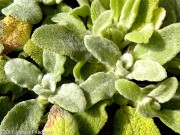Including Rudbeckia, Salvia, & Schizostylis
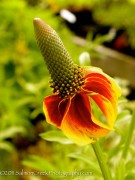
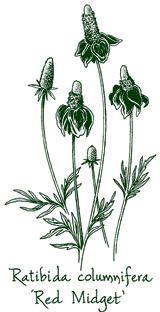
Aptly named, the lax yellow-edged mahogany-red petals encompass distinctive black cones and look like the drooping brims of sombrero hats. Upright, stiff hairy stems are branching and clothed by deeply cut leaves, while bolstering a gazillion flame-hued flowers that entice butterflies and enhance floral arrangements. This drought-tolerant Great Plains toughie lends festive accents to other easy-care perennials and grasses in a border or a natural-style planting.
Blooms July–early October
Size: 18" – 20" high x 18" wide.
Hardy to zone 4.
Rheum
Ornamental Rhubarb
Kin to the edible Rhubarb, these ornamental perennials spawn large brawny leafage and tall intriguing floral spires. Rheum can be utilized as a specimen in the mixed border, the landscape or skirting the water’s edge. They require deep, rich soil and appreciate mulching in the summer to keep their roots cool, as they detest extreme heat.
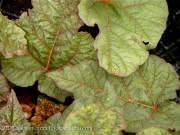
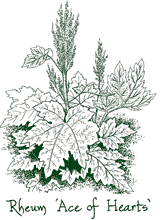
Lustrous, crinkled and richly red when they first unfurl in the spring, large spade-shaped leaves make a bold imposing statement all season long. The grandiose foliage matures to a handsome deep green on top and grows upright, flaunting prominent veins and opulent burgundy undersides, while starry pale pink blooms on tall flower spikes add a dainty touch.
Blooms June–July
Size: 4' 0" – 5' 0" high x 3' 0" – 5' 0" wide.
Hardy to zone 5.
Each $11.00
Headlining a tall wondrous tower clothed in overlapping hand-sized creamy yellow bracts that veil its insignificant flowers and seeds, this magnificent perennial hails from the high altitude, lush marshy meadows and stream sides of Tibet and western China. Deep roots sprout a lustrous, low basal rosette defined by distinctive white-veined lance-shaped leaves. The long lasting scalelike bracts become streaked with burgundy, while autumn brings fiery claret and orange to the foliage.
A seldom-offered rarity, Alexander’s Rhubarb delivers extraordinary architectural panache to a sunny, yet cool, rich damp location.
Blooms May – July.
Size: 3' 0" high x 18" wide.
Hardy to zone 5.

One of the most pleasing of the tall ornamental rhubarbs, this prehistoric-looking specimen has colossal divided leaves that first emerge in reddish bronze tones. Warm weather brings dark green foliar hues on top and purple-infused undersides plus airy maroon panicles surmounting towering flower stalks. Later red shades enliven the foliage for a notable fall finale. Stage with another dynamic performer like Veronicastrum ‘Adoration’.
Blooms June–July
Size: 6-1/2' high x 5' 0" wide.
Hardy to zone 5.
Rodgersia
Native to China and Japan, this spectacular genus will grow in ordinary garden soil, but give it a rich moist home along a pond, stream or marshy area and it will thrive. Rodgersias are fine structural specimens characterized by fleshy brownish black rhizomes, which remain visible through winter. The numerous unpetaled flowers, colored by intriguing creamy-salmon sepals and stamens, are borne on large panicles, and when in bud look almost like miniature cauliflowers. And, be warned! The textured, dark green leaves can spread to a foot across, so be sure to provide these plants with plenty of space.
Rodgersia aesculifolia (P-0311)
Each $13.75
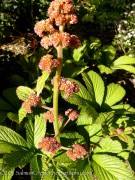
Resembling the palmate leaves of a Horse Chestnut, the crinkled sheenful foliage of this esteemed species is tinted bronze and heavily veined. The 7 leaflets radiate from the center and shaggy brown hair covers the loosely-branched stalks, which hold captivating pyramidal flowers, ranging in color from porcelain white to muted pink.
Blooms June–mid-August
Size: 2-1/2' high x 3' 0" wide.
Hardy to zone 5.
Rodgersia pinnata ‘Chocolate Wings’ (P-2128)
OUT OF PRODUCTION AT THIS TIME
Email me when this plant is available
‘Chocolate Wings’s grace note is the dynamic varying hues that saturate its thick king-size foliage. First emerging in rich purplish chocolate tones, then morphing from green to bronze, the heavily veined 5-parted leaves offer a rubescent fall finale and later welcome winter with warm brown shades. This walloping Marco van Noort introduction volunteers additional springtime enticements: petite dark pink flowers carried on tall arching stems. (PPAF)
Blooms June–mid August
Size: 2' 0" – 3-1/2' high x 2' 0" – 3' 0" wide.
Hardy to zone 5.
Rodgersia pinnata ‘Crûg Cardinal’ (P-2247)
OUT OF PRODUCTION AT THIS TIME
Email me when this plant is available
Named for the exceptional cardinal-red tones its aging deep pink plumes transmute in autumn, this sought-after cultivar was selected by the famed owners of Crûg Farm Plants, Bleddyn and Sue Wynn-Jones. Rubescent clustered buds plus individual small starry blooms embellish the staunch flowering stems above large Chestnut-like green leaves, which are toothed, divided and bronze washed. Sculpting an undemanding, prominently-veined mound, ‘Crûg Cardinal’ lends handsome heft and texture to cool moist abodes.
Blooms June–August
Size: 3' 0" – 4' 0" high x 3' 0" – 4' 0" wide.
Hardy to zone 5.
Rodgersia pinnata ‘Die Stolze’ (P-1723)
OUT OF PRODUCTION AT THIS TIME
Email me when this plant is available
A harbinger of bold drama, ‘Die Stolze’ is prized for its impeccably handsome foliage and wide Astilbe-like floral towers. Large deep green pinnately compound leaves—bronzed when young and affixed to long petioles—entertain shiny pleated surfaces and toothed margins. Warmed by salmon shades, the branched flowering panicles feature rounded clustered buds and copious small starry pale pink flowers. As the sturdy blooms mature, their color deepens, imparting cozy russet hues and retaining their good looks well into October.
Blooms June – mid-August.
Size: 2-1/2' high x 2' 0" wide.
Hardy to zone 5.
Rodgersia pinnata ‘Elegans’ (P-2248)
Each $14.75

Originally found in Helen Dillon’s acclaimed Irish garden, this sensational cultivar is considered by many to be the best form of the species. The gleaming corrugated deep green mass hosts young burnished growth plus mature extrabig, compound leaves, sporting finely serrated margins, while valiant branched stems transform into broad pagodas with clustered petal-less rosy-cream flowers. A high-drama addition to bogs, damp shady borders or waterside plantings, mighty ‘Elegans’ can be ensconced amongst Astilbes and Ligularias, where it promises top-notch copper-hued fall foliage.
Blooms June–August
Size: 3' 0" – 3-1/2' high x 2' 0" – 3' 0" wide.
Hardy to zone 5.
Rodgersia pinnata ‘Superba’ (P-1065)
Each $14.75
A sensational cultivar with prehistoric allure, ‘Superba’ premiers grandiose, heavily pleated pinnate foliage steeped in mahogany hues. New henna-toned stems initially unfurl like a fern, clasping the burnished Chestnut-style leaves that develop an emerald-green cast upon maturity. Perfect for fresh or dried cut arrangements, tall open panicles of clustered star-like bright pink flowers plus deep red stalks rise above the head-turning foliar presentation and captivate us well into fall.
Blooms June–August
Size: 3' 0" – 4' 0" high x 3' 0" – 4' 0" wide.
Hardy to zone 5.
A topnotch foliage plant selected by Ernest Pagels, ‘Braunlaub’ delivers stylish bronzed leaves. Loose ivory-colored panicles reside high above the striking tactile clump composed of prominently veined compound leaves divided into 5 to 7 lobed leaflets with sharply serrated edges. Becoming dark green by midsummer and later transmuting brilliant copper and red autumn hues, this Rodgersia’s large richly colored foliage offsets refined plants like Carex ‘Oehme’ and Thalictrum ‘Elin’.
Blooms June–mid-August
Size: 2-1/2' high x 3' 0" wide.
Hardy to zone 5.
A 1974 Ernest Pagels introduction, ‘Smaragd’ translates to emerald, aptly describing the eye-catching lime-green hues that brighten large tropical-looking leaflets. Jagged toothed margins, broad lobed tips and heavy venation further embellish the lush foliage beneath a marvelous summer display of alabaster-colored Astilbe-like flowers. Infused with cozy bronze tones when young, this somewhat smaller-sized cultivar recently earned a 4-star rating in the Chicago Botanical Garden trials for its consistently robust, winsome bearing.
Blooms June–mid-August
Size: 3' 0" high x 3' 0" wide.
Hardy to zone 5.

A must-have foliage plant selected at Washington’s Bellevue Botanic Garden, this topnotch cultivar brandishes red-tinged chocolate-colored new growth. Open ivory-hued panicles rise high above the striking textural clump, composed of prominently veined compound leaves that are divided into 5 to 9 large leaflets with sharply serrated edges. The stylish richly tinted foliage turns dark green in midsummer, enhanced by occasional ruddy shades and come autumn, transmutes brilliant copper and maroon hues, offsetting fine-hewn plants like Carex ‘Oehme’ and Thalictrum ‘Elin’.
Blooms June–mid-August
Size: 4' 0" high x 18" – 2' 0" wide.
Hardy to zone 4.
A stronghold of daring drama, ‘Rotlaub’ is prized for its newly emerging red leaves, considered the most vividly colored and longest lasting among the species. Defined by lanky petioles, shiny pleated surfaces and jagged edges, the big pinnately compound green foliage entertains bronze, henna and burgundy hues, intensifying as fall approaches. Admirable in the woodlands and in cut arrangements, its sturdy, branched blooming spires feature rounded clustered buds and copious, small starry porcelain-colored flowers, which impart warm russet hues as they age and retain their beauty well into October.
Blooms June–mid-August
Size: 4' 0" high x 18" – 2' 0" wide.
Hardy to zone 4.
Rodgersia sambucifolia (P-0313)
Each $14.75

Named for its immense Elderberry-like foliage, this dramatic clump-forming perennial mosies throughout southwestern China’s moist meadows and woodlands. Substantial rhizomes nurture a grandiose foliar fete of pinnately-compound dark greenery, featuring 3 to 11 sharp-toothed and ribbed, 6 to 8 in. long lanceolate leaflets. Branched, close-knit Astilbe-style plumes dressed in creamy white and pale rose-colored flowers are the summertime icing on the cake!
Blooms June–mid August
Size: 2' 0" – 3' 0" high x 3' 0" wide.
Hardy to zone 4.
Rohdea
Sacred Lily
Each $12.50
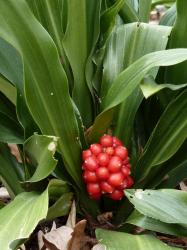
Tropical-looking and tenacious, this rare highly praised Asian perennial premieres slow growing vase-shaped rosettes of long strapping dark green leaves that maintain a textural presence year round. Unusual pineapple-like blooms appear on short stalks followed by brilliant red-orange clustered fruit, persisting through winter and dramatically offset wide, leathery up and outward arching evergreen foliage.
Reminiscent of a Hosta, Sacred Lily makes a handsome container subject or low maintenance ground cover, where it easily tackles deer, drought and deep shade.
Blooms June–July.
Size: 12" – 15" high x 2' 0" wide.
Hardy to zone 6.
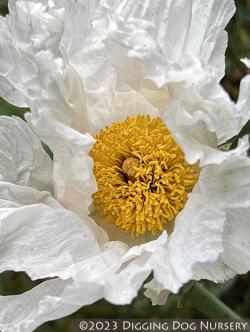
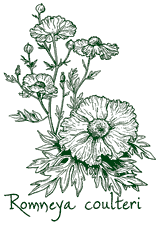
This lusty California lady doles out a generous serving of large, crepe-paper-like white flowers with showy yellow stamens, sunny-side up style. Beautiful, lightly scented, 9 in. wide blooms festoon the upper reaches of stout glabrous stems cloaked in irregularly-lobed gray-green leaves. A shrubby, tough-as-nails perennial that spreads by vigorous rhizomes, the Matilija Poppy’s native haunts include southern California’s Coastal ranges and valleys, and in cultivation, broad beds, hillsides or other formidable sites suit her just fine. Undaunted by deer, poor soil and summer drought, she needs a lot of space, well-drained soil, minimal root disturbance and an annual autumn cut back.
Blooms May–October
Size: 6' 0" – 8' 0" high x 4' 0" & spreading wide.
Hardy to zone 7.
Roscoea
Thrusting upward from fleshy roots late in the spring, Roscoea’s green stems are sheathed by alternate glossy foliage, while its large lobed flowers possess an otherwordly appeal. An exotic-looking genus that counts Ginger among its kin, these Tibetan and Nepalese natives appreciate a deep planting and a thick layer of mulch for winter protection.
Each $11.00

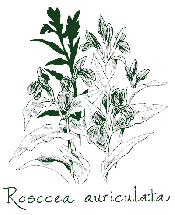
Its grass green leaves are long and lance-shaped. Held on short terminal spikes, the brilliant purple flowers resemble orchids, and display white to pale violet markings on each petal. To create intrigue, plant on the edge of the woodland garden with Heuchera, Tiarellas, and Tricyrtis.
Blooms July–September.
Size: 16" high x 16" wide.
Hardy to zone 6.

Presumed to be a hybrid between Roscoea auriculata and Roscoea cautleyoides, this AGM-winning Ginger relation is named for the English plant nursery Bees Ltd., though its exact origin remains unknown. Springing from hardy tuberous roots, thick upright clumping stems are tightly sheathed in shiny wavy-edged green leaves beneath the wondrous orchid-style cream-colored blooms, that are distinguished by deeply divided labellum plus varying degrees of purple streaks and mottling. Adequately moist, well-drained recesses with dappled light, a thick winter mulch and protection from scorching sun ensure Roscoea x beesiana’s vigor and flowers aplenty.
Blooms July–September
Size: 12" – 18" high x 12" – 18" wide.
Zone 5b/6.
Each $11.00
Once described by British garden author, William Robinson as possessing “...a beauty quite apart”, this rare Chinese woodland perennial lives up to its reputation as its large, openly hooded ghostlike blooms hover just above tall, lush-looking narrow leaves. Bathed in pale moonlit yellows, the exquisitely strange, yet elegant flowers impart a cool luminosity to a drift of Disporum ‘Night Heron’.
Blooms June–July.
Size: 18" high x 12" wide.
Hardy to zone 6.
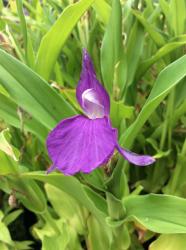
Paying homage to Ginger aficionado William Roscoe, who founded the first Liverpool Botanical Garden in 1803, this Himalayan denizen bears splendid, large orchid-like vibrant purple blooms atop folded green foliage that resembles petite sweet corn leaves. Tuberous, quick-to-clump roots sustain the sturdy, low mounding stalks plus long-blooming hooded flowers. An exotic hardy member of the Ginger family, Roscoea purpurea detests hot humid weather, looks most showy when planted in swaths and lends prismatic floral delicacy to the rockery or a cool moist woodland milieu.
Blooms July–mid September
Size: 12" high x 12" wide.
Hardy to zone 5.
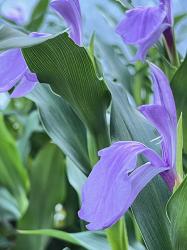
Celebrated for its mighty stalks plus marvelous long-lasting floral display that often extends through September, ′Vincent′s sizable violet flowers are heightened by prominent drooping lower lobes, luminous milky streaks and a mulberry-infused base. Large tapered dark green leaves firmly envelop the upright stems, forging a lush wavy base with a gleaming finish. Lovers of light shade and superb winter drainage, this bushy clump-forming perennial lends late season intrigue to woodland niches, especially when cozied beside Athyrium ‘Red Beauty’ and knitted amid deciduous shrubs, such as Spiraea ‘Ogon’ or Weigela ‘Minuet’.
Blooms July–September
Size: 18" – 20" high x 16" wide.
Hardy to zone 6.
Rudbeckia
Black-Eyed Susan
Named by Linnaeus in honor of his teacher Olaf Rudbeck, this North American genus includes 25 to 30 species, many of them famous summer and late season bloomers. These easily grown selections promise to brighten borders and naturalized meadows plus make dandy additions to bouquets. Offering late fall and winter interest, they combine well with Asters, Eupatoriums and grasses.
Rudbeckia ‘American Gold Rush’ (P-2110)
Each $11.00
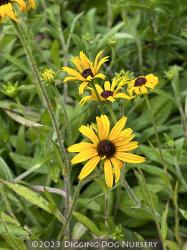
Distinguished from its seed parent by smaller leaves, a compact, shorter stature and superb resistance to leaf spot, this new Intrinsic Perennials introduction is creating quite a stir. The well-groomed dome-like habit sports slender hirsute greenery plus an ebullient showing of copious, ebony-centered bright golden-yellow daisies from summer ’til fall. Enticing plant purveyors, butterflies and songbirds, ‘American Gold Rush’ is a steadfast long-lived perennial for borders, cutting gardens or natural-style plantings. (pp#28,498)
Blooms July–September
Size: 18" – 2' 0" high x 18" – 2' 0" wide.
Hardy to zone 4.
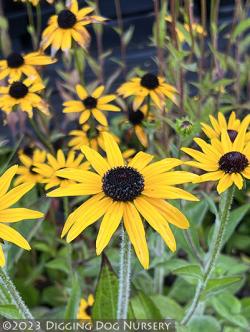
A resilient central and southeastern U.S. native, this undemanding queen of yellow wields her scepter over the late season garden. Each glorious, large golden disc hosts a pronounced velvety dark chocolate center and 12 to 21 ebullient rays. Crowning strong, branched upright stems and hairy, oblong thick dark green leaves, the intriguing pointed green calyces unfurl a profuse sunny gala that entrances butterflies, song birds, florists and plant enthusiasts. Adaptable Deam’s Black-Eyed Susan can be added to stylized meadows, perennial borders and cottage gardens, where she thwarts pests and tolerates occasional drought plus clay or rocky soil.
Blooms July–September
Size: 2-1/2' – 3' 0" high x 15" wide.
Hardy to zone 3.
Rudbeckia fulgida speciosa (Newmanii) (P-0552)
Each $11.00
-854.jpg)
Somewhat wilder looking than most of the well-known cultivars, this species holds bright orange-yellow flowers with densely clustered petals on strong, wiry stems. In our garden, its open habit is backed by Persicaria ‘Summer Dance’.
Blooms late July–September.
Size: 2' 0" high x 2' 0" wide.
Hardy to zone 4.

You probably know ‘Swiss Gold’ as Black-Eyed Susan, those robust, bright orange-yellow American daisies with the dark centers. As charming in seed as it is in flower, its abundant chocolate-brown seed heads last until Thanksgiving. Strong stems bear flowers almost 3 ft. high without staking; foliage is dark green and hirsute.
Set a meadow ablaze with a large drift. Effective with Eupatorium ‘Gateway’, Aster ‘Coombe Fishacre’ and Deschampsia ‘Goldgehänge’ for texture.
Blooms August–October.
Size: 2-1/2' high x 0" & spreading wide.
Hardy to zone 4.
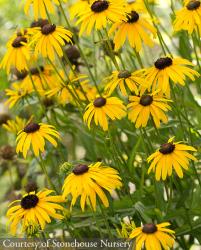
Wildly popular for her over-the-top lambent flower-power and enduring compact stature, this disease-proof selection of our native Black-Eyed Susan occurred at Andre Viette’s Virginia farm and was introduced by Blooms of Bressingham. Tidy, lanceolate deep green leaves and short, stocky upright stems lift a boundless sea of buoyant, daisy-style golden-yellow blooms with purplish cocoa-colored disks. Delighting song birds, pollinators and florists, clumping ‘Viette’s Little Suzy’ can be tucked into meadows, perennial borders, cottage gardens or massed to make a flashy statement, while it triumphs over deer, poor dry soil and air pollution.
Blooms July–September
Size: 18" – 2' 0" high x 18" – 2' 0" wide.
Hardy to zone 3.
Rudbeckia grandiflora ‘Sundance’ (P-1583)
Each $11.00
Reminiscent of a bright French parasol, ample golden-yellow petals are elegantly draped around large, pointed, purplish brown central cones, captivating finches, flower arrangers and plant enthusiasts. An exciting Jelitto introduction selected from the drought tolerant species that inhabits the western Mississippi valley, ‘Sundance’ grows tall with hairy, straight steadfast stems in no need of staking. Good-sized and oblong deep green basal leaves anchor the late blooming fiesta described by a multitude of stalks, each topped by a single sunlit flower. Consider massing in a more natural landscape or nestling into the border with Poa cita and Aster ‘Raydon’s Favorite’ for company.
Blooms August–October
Size: 3' 0" – 4' 0" high x 2' 0" – 3' 0" wide.
Hardy to zone 5.
Rudbeckia laciniata ‘Goldquelle’ (P-1552)
OUT OF PRODUCTION AT THIS TIME
Email me when this plant is available
This Rudbeckia’s sassy Dahlia-like mop of double lemon-yellow flowers promises to put a smile on your face. Perched atop wiry upstanding stems and handsome narrow-lobed green leaves, the shapely chartreuse-eyed daisies bloom for a long time, while creating a dramatic medium-sized counterpoint to Aconitum ‘Bressingham Spire’s vertical blue-violet shafts.
Blooms mid-July – September.
Size: 2-1/2' – 3' 0" high x 2' 0" wide.
Hardy to zone 4.
Rudbeckia occidentalis ‘Green Wizard’ (P-1294)
Each $11.00
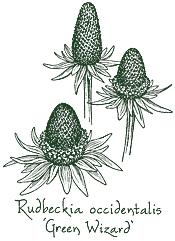
If you appreciate the curious, the unusual, the truly unique, then allow this novelty to work some magic in your garden. From a leafy green basal clump appear 3 to 5 in. wide flowers on sturdy stalks, each featuring a huge central chocolate brown boss encompassed by approximately ten large and stiff well-spaced bright green sepals.
Unparalleled as a cut flower fresh or dried, florists, gardeners and birds seek out these extraordinary blooms that first form an intriguing golden ring of pollen around their striking cones. Quick to establish and undemanding, this attention grabber guarantees a flashy display of neon color when paired with Kniphofia linearifolia and Salvia ‘Limelight’.
Blooms July–September.
Size: 3' 0" – 5' 0" high x 2-1/2' wide.
Hardy to zone 4.
Languid petals in lemon yellow shades lazily encircle prominent beehivelike, chartreuse cones during the idle days of summer. With rough surfaces and fuzzy undersides, the broad and deeply clefted green leaves attire sturdy clumping stems in an airy, opposite fashion. This Rudbeckia makes a sunny neighbor for Aster asperulus above our stone wall.
Blooms July–August.
Size: 3' 0" – 4' 0" high x 2' 0" wide.
Hardy to zone 4.

A Midwestern prairie girl that delivers outstanding flower power along with unwavering fortitude, this taller Black-Eyed Susan cousin is named for her anise-scented daisies. Radiant yellow petals surround purple-brown domed centers creating a buoyant sea of color all summer long. Perfectly branched for bouquets, the sturdy, straight-backed stems host toothed, deep green lush-looking leaves sporting downy undersides.
Blooms August–September.
Size: 4' 0" high x 2' 0" wide.
Hardy to zone 3.
Rudbeckia subtomentosa ‘Loofahsa Wheaten Gold’ (P-2250)
OUT OF PRODUCTION AT THIS TIME
Email me when this plant is available
Named after one of his beloved prize-winning Wheaten terriers, this comely late-summer bloomer was bred by Anthony Brooks, the head gardener at England’s Elton Hall. Countless ample-sized clear yellow blooms with cocoa-colored cones plus slim, widely-spaced pointed petals, which twist and undulate, cast a graceful somewhat ruffled aspect above attractive green foliage on tall stems. Kin to the stalwart Midwestern U.S. native, ‘Loofahsa Wheaten Gold’ acquiesces to dry periods and some shade, while enjoying bedfellows such as Eupatorium ‘Purple Bush’ and Persicaria ‘Fat Domino’ in sunny moderately-moist enclaves.
Blooms August–September
Size: 4' 0" – 4-1/2' high x 2' 0" wide.
Zone 3/4.
Rudbeckia triloba ‘Prairie Glow’ (P-1713)
Each $11.00
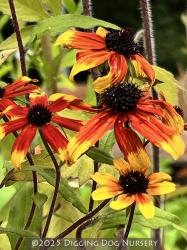
Spangled with burgundy, bronze and reddish orange shades, irresistible legions of exuberant long-blooming daisies debut dark chocolate centers and bicolored gold-tipped petals. Large trilobed verdant leaves sprout from ‘Prairie Glow’s base, forming a handsome bushy mass that gives way to upper, narrower leaves and openly-branched erect purple-flowering stems. A denizen of the Great Plains, this summertime show-stopper is not as persistent as other Rudbeckias; it eventually wears out, but easily reseeds.
Blooms July–mid-October
Size: 3' 0" – 4' 0" high x 15" wide.
Hardy to zone 3.
Salvia
Sage
Thought in ancient times to perpetuate good health, an Arab proverb asks, “How shall a man die with sage in his garden?” Our Salvias are diverse perennials, shrubs or subshrubs, many hailing from the Mediterranean, Mexico, South America and some of our western states. Reliable once established, and generally undaunted by pests, disease and drought, they combine an array of flowers and often aromatic foliage in many different sizes, shapes and hues.
Salvia x ‘Allen Chickering’ (P-0336)
OUT OF PRODUCTION AT THIS TIME
Email me when this plant is available
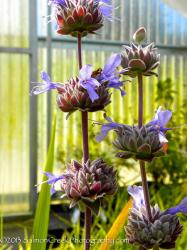
Undaunted by deer and drought, this Salvia leucophylla and Salvia clevelandii progeny is a California native originating at Rancho Santa Ana Botanical Gardens. Brew a delicious tea from its spicy scented, graygreen leaves and delight in the hummingbirds, bees and butterflies drawn to its abundance of tubular deep lavender blooms that comprise evenly spaced, ball-like clusters. With a dense shrubby profile, this good-looking reliable Sage will grow quickly in a sunny well-drained locale.
Blooms June–August.
Size: 3' 0" high x 3' 0" – 4' 0" wide.
Zone 7/8.

This bold Mediterranean native serves up a remarkable portion of eye catching appeal on its almost platter-sized, soft and silky white, felted foliage. Emerging in a dramatic basal clump, new leaves are crinkled, but flatten as they grow, while their margins retain a sinuous wave. A spectacular showing of dramatic 2 to 3 ft. candelabralike stems are decorated in small, white, hooded flowers, each with a slight tinge of pink and a subtle grayish calyx.
After the bloom, leaves transmute to a pale gray-green, and when cooler weather returns, they turn silvery once again. Positively show-stopping along a dry wall, or in the herb garden with Lavender and Rosmarinus ‘Maltese White’, Salvia argentea demands well drained soil, tolerates drought, and will live longer if spent flower stalks are attentively removed.
Blooms June–July.
Size: 5' 0" high x 3' 0" wide.
Zone 5b/6.
OUT OF PRODUCTION AT THIS TIME
Email me when this plant is available

A loose mound of luxuriant verdant foliage and trailing stems, this native of southern Arizona, Texas and northern Mexico thrives in the partial shade of small trees and shrubs. With a multitude of small, bright purple flowers held by smoky violet calyxes and a refreshing minty scent, Arizona Sage makes a delightful understory for Euphorbia griffithii ‘Great Dixter’.
Blooms June–July & again in September.
Size: 18" high x 2' 0" & spreading wide.
Hardy to zone 7.
One of famed designer Piet Oudolf’s Top 100 ‘Must Have’ plants, this stalwart U.S. denizen is prized for its enchanting, late season sky blue racemes. The vibrant two-lipped cerulean blooms populate 12 in. long terminal wands from mid-summer ’til frost, lolling upon slender upright stems clad with slim, fuzzy, linear green leaves. Cherished by butterflies and hummingbirds, Salvia azurea grandiflora lends elegant easy-care accents to sunny well-drained borders, rock gardens, water-wise plantings and prairie-style venues. Though it roams wild in the southeastern states, as well as Texas, New Mexico and north to Nebraska and Minnesota, Azure Sage will heroically tackle deer, drought, lean rocky soil and humidity in your back yard plus look bushier when given a late spring cut back.
Blooms August–October
Size: 4' 0" – 5' 0" high x 2' 0" – 3' 0" wide.
Hardy to zone 4.
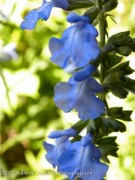
Highly esteemed for its densely packed whorls of powdery sky-blue flowers, this U.S. native assures a scene stealing, late season hurrah that beckons both butterflies and other garden visitors. Numerous slender stems stand tall, bearing narrow, linear grayish green leaves. Exhibiting unwavering drought, heat and cold tolerance, this stalwart beauty deserves a prime position in more gardens.
Blooms July–September
Size: 3' 0" – 4' 0" high x 2' 0" – 3' 0" wide.
Hardy to zone 4.
A bee’s bliss, a gardener’s good friend, and very welcome indeed is this Salvia’s ability to grow in difficult, dry conditions. An excellent ground cover, ‘Bee’s Bliss’ bears abundant clusters of lavender-colored blossoms, which embellish its bright, dense mat of slender-leafed, aromatic, gray-green foliage. It willingly spills over a wall, softening hard edges, and maintains a tidy look without much care.
Blooms June–August.
Size: 12" high x 3' 0" wide.
Hardy to zone 9.
Each $12.00
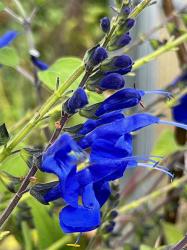
Hats off to esteemed Salvia aficionado Betsy Clebsch for this stylish semievergreen Salvia macrophylla and Salvia sagitata cross. Festooned with big electrifying cobalt-blue blooms, strong, upright branching stems rise well above a compact fast-growing grayish green mound of large, arrow-shaped velvety leaves. The quintessential ‘foliage rivals flowers’ Salvia, it appreciates sunny, well-drained enriched niches, while its nearly year-round blossoms wow bees, butterflies, hummingbirds and plant connoisseurs. A textural tropical-looking perennial, ‘Big Swing’s easy-care yet tender persona braves deer, heat and dry conditions.
Blooms July–October
Size: 3' 0" – 4' 0" high x 2' 0" – 2-1/2' wide.
Hardy to zone 8.

The species hails from California’s Channel Islands, while the vigorous cultivar comes from a selection made at the Santa Barbara Botanical Garden. Possessing a versatile tough-as nails persona, long-lived ‘Pacific Blue’ is an upright, mutistemmed shrubby Salvia defined by arched branches and winsome, dark green slender leaves with pebbled surfaces, felted white undersides and a spicy scent. Abundant tiered whorls of dark lavender-tinged blue blooms adorn this fast growing, hummingbird minion that can handle extreme drought, summer water and an array of soils.
Blooms April – June.
Size: 3' 0" – 4' 0" high x 4' 0" – 6' 0" wide.
Hardy to zone 8.
Each $12.00
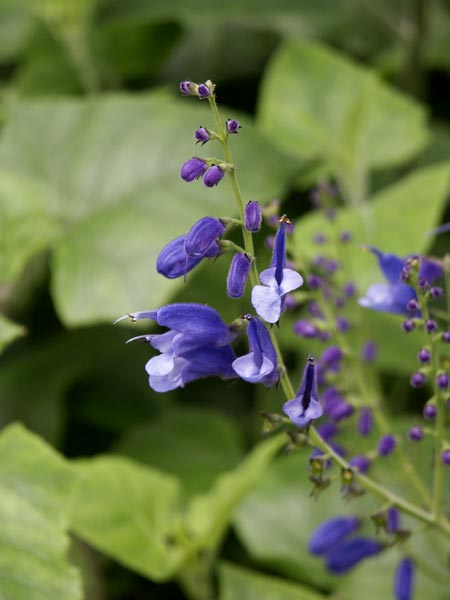
Recommended some 70 years ago by British garden writer William Robinson, this exceptional long-blooming Salvia offers fuzzy gentian-blue flowers. Its small but abundant, intensely painted blooms garnish terminal racemes above a many stemmed, emerald-green foundation of thick triangular leaves. Indigenous to the mountainous regions of southern Mexico, Honduras and Guatemala, Salvia cacaliifolia can be found growing as high as 8,000 ft., its slow-to-spread, creeping roots thriving with well-drained soil, regular water and high shade. A harbinger of cool, late season floral color, it can be positioned right up front next to Geum ‘Starker’s Magnificum’.
Blooms July–October
Size: 2' 0" – 3' 0" high x 3' 0" – 4' 0" wide.
Hardy to zone 8.
A high-elevation, cloud forest denizen of Chiapas, Mexico, this tender Salvia champions dark green varnished leaves and bright fuchsia-colored blossoms. Widely spaced whorls house grape-hued calyxes and flashy flowers above an airy evergreen foundation of upright stems and deeply veined elliptical leaves, which are attached by long reddish petioles. Tantalizing in a container, hanging basket or the perennial bed, Chiapas Sage detests poor drainage, prefers moderate water, needs a protected winter spot and a pruning to maintain its bushy shape.
Blooms July – October.
Size: 2' 0" – 3' 0" high x 3' 0" – 4' 0" wide.
Zone 8/9.
Salvia clevelandii ‘Whirly Blue’ (P-1502)
OUT OF PRODUCTION AT THIS TIME
Email me when this plant is available
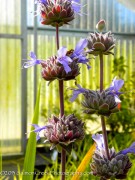
Native to southern California’s chaparral country and distinctive amongst the shrubby sages for its large deeper colored blossoms, you can usually smell this extremely long blooming, drought tolerant cultivar before it comes into view. The pleasantly sweet and woody aroma is a grace note to its handsome habit. Evergreen, narrow linear leaves have a pewter green tone, punctuated by a springtime flash of bright green stems. Excellent in dried arrangements, ‘Whirly Blue’s rich violet flower whorls, enhanced with dusky mulberry-colored calyxes, are favored by hummingbirds, bees and butterflies. Prune regularly to ensure an attractive appearance.
Blooms June – October.
Size: 4-1/2' high x 4' 0" – 5' 0" wide.
Hardy to zone 8.
Salvia clevelandii ‘Winnifred Gilman’ (P-1867)
OUT OF PRODUCTION AT THIS TIME
Email me when this plant is available
Introduced to the nursery trade in 1990, this sterling California native has plenty of merit: prismatic, long-lasting pollinator friendly flowers, a compact rounded habit with handsome gray-green foliage and a delightful, spicy sweet fragrance plus herculean drought tolerance. Profuse, richly colored sphere-like whorls house electric blue-purple blooms and dark ruby-hued calyces that lend gorgeous textural additions to fresh or dried arrangements. A true selection of California’s Blue Sage, ‘Winnifred Gilman’ appreciates a light trim as well as sharp drainage and makes a galvanizing deer-resistant statement above a rock wall, in a native garden or Mediterranean venue.
Blooms July–September
Size: 3' 0" high x 3' 0" wide.
Hardy to zone 8.
Each $12.00
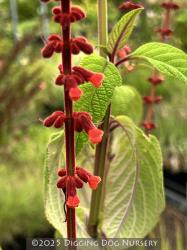
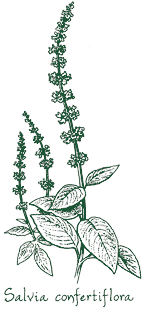
With velvety, reddish purple stems, smooth, bright green new foliage that matures to a textured dark green, and fuzzy vermilion flowers, this Brazilian native is lush and tantalizing. A wonderful addition to cut arrangements, the 6 to 10 in. long flower spikes make a bold statement in the fall border, either amid Asters and grasses or combined with mounding perennials.
Blooms September–November.
Size: 5' 0" high x 3' 0" wide.
Hardy to zone 9.
Each $12.00
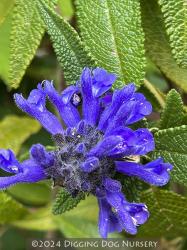
Widely distributed in the Andes from southern Colombia to Peru, Salvia corrugata features deeply puckered, dark green leaves. While newly emerging foliage sports downy, copper-colored undersides, each mature lance-shaped leaf has a sheen on top and contrasting grayish tomentose below. Fuzzy, light gray-green stems are crowned with showy racemes of deep blue flowers held by violet calyces. This celebrated Salvia can be utilized as a distinctive upright specimen for the mixed border.
Blooms August–October
Size: 3-1/2' – 5' 0" high x 3' 0" wide.
Hardy to zone 9.
Salvia ‘El Cielo Blue’ (P-0866)
Each $12.00
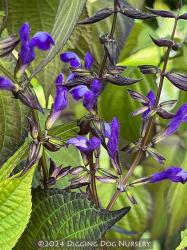
Selected by Yucca Do Nursery, the interesting foliage of this upright Mexican native makes it one of our favorite Sages. Broad, tapered leaves have an unusual bluish hue on top, while undersides turn purple as they mature. Contrast this with the vivid green of the new growth, and you’re in for quite a foliar show. Well loved by hummingbirds, the small, iridescent, deep purple flowers display a splash of white in their throats.
Blooms late August–October.
Size: 4' 0" high x 2' 0" wide.
Zone 8/9.
Acclaimed garden designer, Piet Oudolf selected this wonderful Salvia pratensis hybrid for its tidy compact habit and unusual two-toned prolific blooms. Tall, upright sturdy branched spires parade a bevy of carmine-colored buds and pink flowers nestled in dark purple calyces. Light green aromatic leaves—ovate, wrinkled and sporting crenate margins—weave a comely basal clump that wards off deer, tantalizes the hummingbirds, requires good air circulation and favors a trim after blooming to promote new growth. (uspp#14,905)
Blooms May–July
Size: 20" – 2' 0" high x 15" – 18" wide.
Hardy to zone 4.
Each $11.75
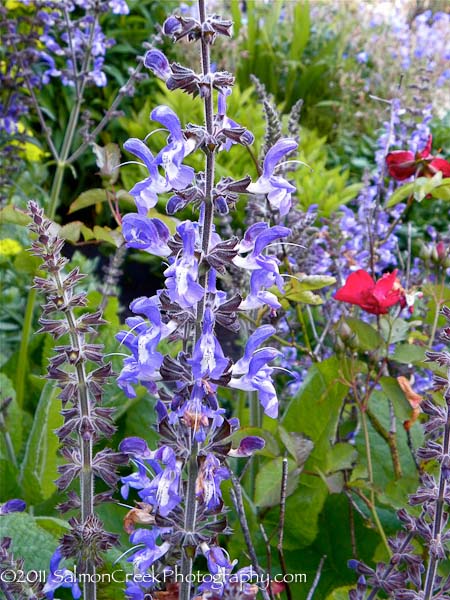
The large, almost triangular leaves of this Bulgarian native make a striking base for the long spires of white-streaked, violet-blue blooms. Robust flower stems arch gracefully above the basal foliage, which lies close to the ground. Accent the beautiful foliage and position midborder in well drained soils with fine textured perennials and grasses like Miscanthus sinensis ‘Morning Light’.
Blooms June–September.
Size: 2' 0" high x 3' 0" wide.
Hardy to zone 6.
Easily adapting to humidity and higher elevations of up to 10,500 ft., this versatile, rarely offered Mexican native hosts a light airy bundle of small triangular, dentate leaves topped by sparkling azure blue flowers with white-banded lower lips. Wiry stems give way to fuzzy looking buds that generously unfurl on short spikes from summer ‘til the season’s end. Related to S. sinaloensis and S. uliginosa, undemanding S. glechomifolia appreciates loose well-drained soil, and can be featured spilling over a container’s edge or colonizing alongside a garden path as a colorful companion for Phygelius ‘African Queen’.
Blooms July–early November
Size: 12" – 18" high x 18" wide.
Hardy to zone 8.
Salvia greggii ‘Lowry’s Peach’ (P-1139)
Each $11.75
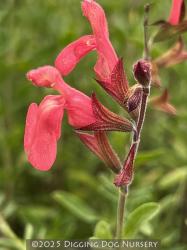
And what a peach it is! Indigenous to the hills above Ciudad Victoria, capital of a northeastern Mexican state, this drought-busting evergreen Salvia entertains rosy coral-colored flowers with butter-yellow throats plus cocoa-hued calyxes nearly nonstop from the last frost until the first. Dapper, small polished green leaves and branching wine-tinged stems distinguish the compact shrubby habit. Prized by bees, butterflies and hummingbirds, no-fuss ‘Lowry’s Peach’ begs good drainage and periodic pruning, while promising a prismatic show in water-wise gardens and mixed borders, especially when featured en masse.
Blooms July–September
Size: 2-1/2' high x 2-1/2' wide.
Hardy to zone 8.
Salvia x ‘Nuevo Leon’ (P-0370)
Each $11.75
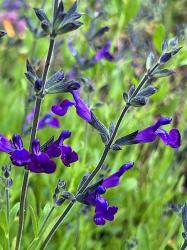
Hailing from Mexico and Texas, this long-blooming greggii species fashions a shapely mound clad in slim spicy-scented green leaves. Upright racemes of plentiful petite royal-purple flowers and plum-tinged calyxes adorn the fine-textured, mostly evergreen base that becomes somewhat woody with age. Relished by honeybees, butterflies and hummingbirds, Salvia x ‘Nuevo Leon’ savors superb drainage, lean soil and moderate moisture, yet easily endures heat, dry sites, pesky deer and chilly weather.
Blooms June–September
Size: 2' 0" – 3' 0" high x 18" – 2' 0" wide.
Zone 7b/8.
Salvia greggii ‘Wild Thing’ (P-1224)
Each $11.75
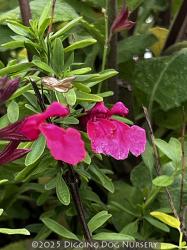
Plant aficionado Tom Peace helped establish this lavishly hued, west Texan’s notoriety. Quick to grow, full of vigor and more tolerant of cold damp winters than most greggii species, ‘Wild Thing’ promotes good-looking glossy green foliage and droves of bright cherry-pink flowers with contrasting wine-colored calyces. Plant next to Crocosmia ‘Fire King’ and Verbascum ‘Gainsborough’ for a wild enduring association.
Blooms June–September
Size: 3' 0" high x 3' 0" wide.
Hardy to zone 6.
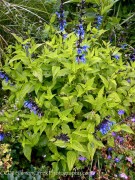
An absolute favorite of our hummingbirds, this eye catching Salvia offers abundant, deep cobalt blue, tubular blooms and nearly black calyxes on 15 in. terminal flowering spikes all summer long. More compact than many of the guaranitica species, ‘Black and Blue’ provides complementary color for the shining blooms of Crocosmia ‘Star of the East’.
Blooms mid-July–October.
Size: 3-1/2' high x 3' 0" wide.
Zone 7/8.
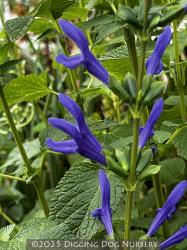
Pennantlike spikes of large, Cambridge blue, tubular flowers and bright green calyxes proudly rise above the spade-shaped leaves, which cloak ‘Blue Ensign’s upright, but freely branching stance. A drift mid-border makes a compelling statement with the yellow-orange coloring of Euphorbia ‘Fern Cottage’s fall foliage nearby.
Blooms mid-July–October.
Size: 3-1/2' – 4' 0" high x 3' 0" wide.
Hardy to zone 7.
Each $11.75
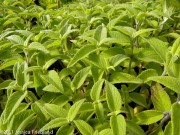
Hailing from the cool highlands of Guatemala and Chiapas, Mexico, this vigorous Salvia volunteers hundreds of brilliant cardinal red, whorled blossoms in late fall. A yellow-green cast infuses young growth while mature leaves are darker green. Marked by light green grooves, the numerous, wine-infused lax stems become obscured by prominently veined triangular leaves, which taper to pronounced narrow tips.
Paying homage to Edward Holway, an American mycologist and plant collector who traveled to Mexico in the early 1900s, Salvia holwayi blooms all winter long in warmer areas, gracing its lush and bushy good-sized mass with much appreciated color and hummingbird food.
Grateful for a well drained, humus rich spot and a hard cut after blooming, it creates a verdant backdrop for the mixed border, an excellent conservatory plant in colder climates and a splendid long lasting cut flower when they’re aren’t many others around.
Blooms October–December.
Size: 4' 0" high x 4' 0" – 6' 0" wide.
Hardy to zone 9.
Large and rounded, dusky magenta buds cluster at stem tips and open into brilliant pink, fuzzy tubular flowers toned down by deep purple calyxes. Handsome, dark green nearly heart-shaped leaves are arranged in pairs and complement red petioles on strong straight stalks.
Revered by hummingbirds, this bushy Salvia makes a perfect addition to the meadow garden, and along with Salvia ‘Nekan’ and Aster ‘Ochtendgloren’ augments a late season blend of blue and pink.
Blooms August–mid-October.
Size: 4' 0" high x 3' 0" wide.
Zone 8/9.
Salvia involucrata ‘Mulberry Jam’ (P-0713)
Each $12.00
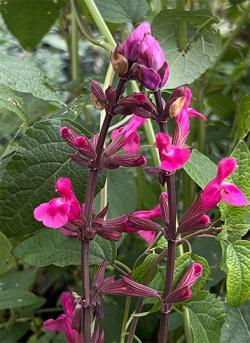
A hummingbird-friendly selection from Betsy Clebsch’s garden, ‘Mulberry Jam’ is smaller and more upright than the species. Large, rounded, dusky-magenta buds open into fuzzy, vibrant pink tubular flowers toned down by deep purple calyces. This lovely bush-like Salvia makes a perfect addition to the meadow garden with Salvia ‘Nekan’ and Aster ‘Ochtendgloren’ for a blend of late season blue and pink.
Blooms June–mid-October
Size: 4' 0" high x 2' 0" wide.
Hardy to zone 8.
Salvia x jamensis ‘Pat Vlasto’ (P-1107)
OUT OF PRODUCTION AT THIS TIME
Email me when this plant is available
One of the toughest cultivars of the species, this radiant long blooming Sage can handle a variety of growing conditions. Against a fine textured background of small, glossy green leaves, the watermelon-colored flowers are offset by red-hued stems and sable-colored calyxes. For echoes of warm color, pair ‘Pat Vlasto’ with Phygelius ‘African Queen’.
Blooms June–mid-October.
Size: 3' 0" high x 3' 0" wide.
Hardy to zone 8.
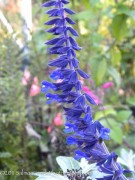
Frances Parker of South Carolina discovered this unlikely cross and named it for her grandson. Blessed with attributes from both parents, ‘Anthony Parker’ features extraordinary, nearly 2 ft. long spires of midnight purple-black, leucantha-like flowers topping attractive leaves and young downy white stems. The broad-based, grayish green foliage tapers to a point, and displays a venation similar to Salvia elegans.
Gracing an herbaceous border or even an arrangement, this robust Salvia’s dark flowers will set Sedum ‘Autumn Fire’ aglow.
Blooms August?October.
Size: 3' 0" – 4' 0" high x 4' 0" wide.
Hardy to zone 9.
OUT OF PRODUCTION AT THIS TIME
Email me when this plant is available
Discovered amongst a patch of Salvia hians by famed Dutch garden designer Piet Oudolf, this distinctive 2009 introduction premiers 2 ft. tall branching spires with standout bicolored flowers swaying above a large bushy basal rosette. Appealing 7 in. long, lusty green leaves ground the sturdy upright stalks, which house copious whorled blooms, each with a blue-violet upper calyx, white lower lip and prominent, lanky blue-tipped niveous stigma. A hummingbird darling for the border or cottage garden, ‘Madeline’s undemanding verve prospers in sunny free-draining nooks, while her early summer blossoms are persistent, either outside or in a vase. (pp#20,456)
Blooms May–June
Size: 2' 0" high x 18" wide.
Hardy to zone 5.
Salvia melissodora (Yucca Do Form) (P-0774)
Each $12.00
The name of this charming Sage, long used by the Tarahumara Indians of Mexico for medicinal purposes, comes from the Greek words meaning fragrant and honeybee. Bees, moths, butterflies and hummingbirds alike are attracted to the sumptuous, nectar-laden panicles of pleasantly scented, periwinkle flowers and fuzzy, sable-colored calyxes.
Elegant leaves with downy silver undersides embellish its graceful upright presence.
Blooms May–October.
Size: 5' 0" – 6' 0" high x 3' 0" wide.
Hardy to zone 9.
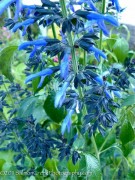
Lavish dark buds are a prelude to the striking compact whorls of fuzzy purple flowers and black calyxes displayed on 18 in. spikes. ‘Compton’s Form’ has distinctive, deep green polished foliage, a bit finer textured than that of ‘Limelight’, and an erect, bushy habit.
Blooms August – early November.
Size: 5' 0" high x 4' 0" wide.
Hardy to zone 8.
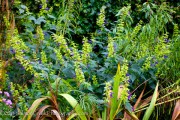
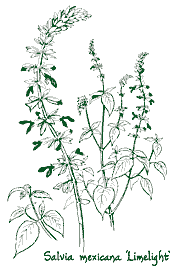
Set against ‘Limelight’s large lush greenery, whorls of densely packed chartreuse terminal buds on strong upright stems heighten our anticipation. The amazing 2-toned floral effect takes center stage with deep bluish purple blooms peeking out from electric yellow-green calyces. Cut back each season to encourage new growth at the base and to maintain a pleasing shape.
Blooms August–early November
Size: 6' 0" high x 6' 0" wide.
Hardy to zone 8.
Collected by the astute folks at Texas’s Yucca-Do nursery, ‘Tula’ wields brighter yellow calyxes plus a larger habit than its botanical rival Salvia ‘Limelight’. Nectar-rich deep blue-violet flowers along with the contrasting close-knit chartreuse calyxes embellish dazzling long spires, seducing plant enthusiasts, hummingbirds and butterflies alike. A bushy gathering of light-colored thick branching stems, draped in broad soft gray-green foliage, this leafy late season prismatic Salvia spices up mixed plantings, requires winter protection below 20 degrees and benefits from periodic spring and summer pruning.
Blooms August–early November
Size: 7' 0" high x 7' 0" wide.
Hardy to zone 8.
Each $11.75
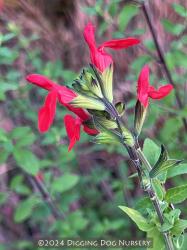
Naming this natty Salvia "small leaves" is like identifying a Ferrari by its tires. The long blooming scarlet-red flowers and thick wine-red stems, which are inscribed with a notable silver-white stripe running down each side, provide dynamic counterpoints to pleasantly scented, lustrous green serrated leaves. Indigenous to southeastern Arizona and Mexico's mountainous regions, where it is known as "myrtle of the mountain", our cutting propagated strain forges a dense, shrubby evergreen patch. The proud parent of many popular cultivars, its steadfast good looks promise a lot of mileage.
Blooms July–October.
Size: 3' 0" high x 3' 0" wide.
Zone 8/9.
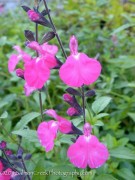
Touted as one of the best pink-colored microphyllas, these good-sized flowers are not shy in the least. With a full-bodied fuchsia pink hue, the freely borne blooms feature dark charcoal-tinged calyxes, hooded upper petals and prominent lower lips illuminated by singular white splotches. Peaking in spring, continuing through summer and ending with an autumn grand finale, the exuberant long lasting display energizes a bushy aromatic mass of wiry stems and green blunt-tipped, finely toothed leaves. This Salvia remains relatively root-hardy through chilly winters.
Blooms May – October.
Size: 3' 0" – 4' 0" high x 3' 0" wide.
Hardy to zone 8.
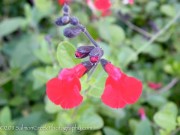
Big, brilliant and red, these lavishly colored flowers are double the size of any other microphylla or greggii. Blooming spikes and calyxes the color of dark chocolate dramatically present the plush-as-velvet showing, while a handsome, full bush of glossy, somewhat rounded rich green foliage supports it.
Introduced by Texas’s Yucca-Do Nursery and Scott Ogden, ‘Red Velvet’ thrives in warm, dry climates, can endure humidity and assures a vivacious presence, especially when partnered with Penstemon Chiapas sp.
Blooms June–October.
Size: 4' 0" high x 4' 0" wide.
Hardy to zone 7.
Salvia microphylla ‘Hoja Grande’ (P-1421)
Each $12.00
Painted in pretty lipstick shades of cherry-red and magenta, slender whorled flower spikes festoon this shrubby evergreen Salvia. Warm, rosy brown calyxes and attractive ripple-edged green leaves heighten the showy long lasting blooms.
Introduced by Yucca-Do Nursery, the amenable ‘Hoja Grande’ hails from Mexico’s Nuevo Leon, and in our garden jazzes up neighboring Phlomis russeliana, while easily tolerating dry conditions whether the weather’s hot or cool.
Blooms May–June & September–October.
Size: 3' 0" – 4' 0" high x 3' 0" – 4' 0" wide.
Hardy to zone 7.
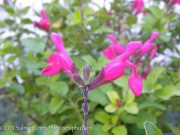
This well-loved captivating Salvia celebrates a festival of color! Splashed with highly saturated magentas and lavish ruby throats, the dazzling flowers unfurl from sable-colored calyxes by the hundreds, beginning in spring and lasting through fall. Each textured medium green leaf emphasizes undulating serrated margins, a somewhat triangular shape and bronzy winter tones. Discovered in Tamaulipas, Mexico, ‘San Carlos Festival’s extraordinary floral abundance and attractive compact form can be staged right up front in a water wise garden.
Blooms May–November.
Size: 2' 0" high x 2-1/2' – 3' 0" wide.
Zone 7/8.
Salvia microphylla ‘Wild Watermelon’ (P-1360)
OUT OF PRODUCTION AT THIS TIME
Email me when this plant is available
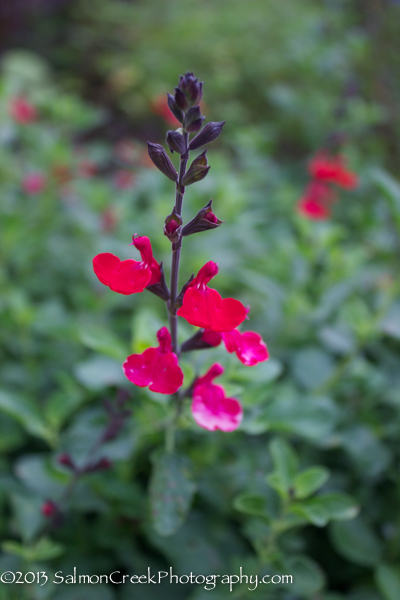
“Exuberant” best describes the way extra large, deep watermelon-pink flowers dress up this robust, relatively cold resistant Salvia.
Collected by Don Mahoney at 7000 ft. on Mexico’s Mt. Cerro Potosi, ‘Wild Watermelon’ not only boasts boisterously colored blooms with white-marked throats but neat good-looking foliage and a hardy crown that spreads by layering itself. Most abundant in spring and fall and only sporadically over the summer, its high-spirited floral hues invite a glance either spotlighted in a favorite pot, or backed by white blooming Cistus in the mixed border.
Blooms May–June & again in September–October.
Size: 3' 0" – 4' 0" high x 4' 0" wide.
Zone 7/8.
Salvia moorcroftiana ssp. x indica (P-1951)
OUT OF PRODUCTION AT THIS TIME
Email me when this plant is available
Discovered as a chance seedling at California’s Suncrest Nursery, this long blooming Salvia inherits the most appealing traits of both its parents. The textural bluish green basal rosette of sturdy, wavy-edged broad leaves held by lanky petioles produces thick up-curved stalks, bearing whorled lavender blue flowers with purple spotted pale-hued lips. Ideal for a well-drained mixed border, Shangri-La Sage musters lovely pastel blooms, outstanding bold evergreen foliage and an undemanding mettle that requires reasonable drainage and moderate water.
Blooms May–July
Size: 2' 0" – 3' 0" high x 2' 0" – 3' 0" wide.
Zone 7b/8.
Salvia nemorosa ‘Amethyst’ (P-0813)
Each $12.00
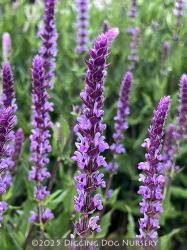
This long-blooming Salvia’s signature is its spectacular jewel-like tones. Firm burgundy-streaked leafy stalks boost the violet-blue blossoms that are lodged within enduring rosy-purple calyces, while wavy-edged foliage shapes a full handsome green habit. Softening the edge of our pathway alongside Origanum ‘Ed Carmine’, a purple theme is created and the addition of Kniphofia ‘Bee’s Sunset’ adds a lively yellow-orange splash.
Blooms early June–September
Size: 2-1/2' high x 3' 0" wide.
Hardy to zone 5.
Salvia nemorosa ‘Blue Marvel’ (P-2057)
OUT OF PRODUCTION AT THIS TIME
Email me when this plant is available
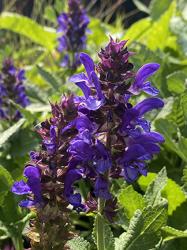
Boasting the largest flowers among the species, this award-winning Salvia is a recent Ball Horticultural introduction. Neat, spice-scented green foliage denotes the dwarf leafy foundation beneath a marvelous display of big rose-colored buds plus ample-sized, saturated deep violet-blue flowers with burgundy calyces. A reliable rebloomer when deadheaded and a haven for pollinators, carefree ‘Blue Marvel’ headlines show-stopping flower-power in a rock garden, butterfly bed, container or mixed border. (pp#27,018)
Blooms June–early October
Size: 10" – 12" high x 12" wide.
Hardy to zone 4.
Salvia nemorosa ‘Caradonna’ (P-1133)
Each $11.25
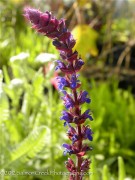
Shaded by unique blackish magenta hues, the long straight stems of this superb cultivar make a dark and dazzling, lustrous foil for violet flowers that bloom well into fall with attentive deadheading. While its origins stem from a chance seedling found in a German nursery, ‘Caradonna’s tidy base of textured green foliage and purple blooms adds harmonious accents to neighbors like Sedum ‘Jose Aubergine’ in your garden.
Blooms July–early October
Size: 2' 0" – 2-1/2' high x 3' 0" wide.
Hardy to zone 4.
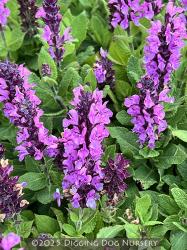
Introduced by Dummen Orange, a Dutch breeding program, this color-rich Midnight series Salvia debuts a spectacular tight-set bouquet of rose-pink blossoms plus wine-hued calyxes that crest short upright maroon stems. Textural, low-growing lanceolate green leaves with fine-toothed margins shape a snug refined habit below the readily reblooming nectar-laden flowers. Equally at home in rustic or urban settings, small-statured ‘Midnight Rose’ can grace stone walls, border frontlines, cottage gardens, space-thrifty landscapes, pathways and containers, rambling amongst Achillea ‘King George’, Hemerocallis ‘Corky’ and Lavandula ‘Thumbelina Leigh’. (PPAF)
Blooms June–August
Size: 18" high x 18" – 22" wide.
Zone 4b/5.
Studded with radiant bluish violet flowers, crowded spires rise above a low growing shapely bed of textured green crimple-edged leaves. Persistent darker purple calyxes festoon the long lasting floral splendor, extending interest well after the tubular petals are spent. A compelling European cultivar that is hard to find in this country, ‘Negrito’ makes an ideal trouble free companion for the rosy hues of Origanum ‘Lizzie’s Hybrid #2’ and Sedum ‘Red Cauli’.
Blooms June–early October.
Size: 2' 0" – 2-1/2' high x 3' 0" wide.
Hardy to zone 4.
Salvia nemorosa ‘Rosenwein’ (P-0966)
OUT OF PRODUCTION AT THIS TIME
Email me when this plant is available
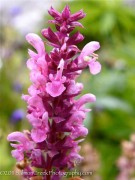
German for ‘Rose Wine’, let this Salvia bathe your garden with bright rose-hued flowers. Adorning a low mound of tidy green foliage, the upright leafy spikes are offset by prominent, dark earthy pink calyxes and buds of the same shade. Position in the front of the border with Geranium ‘Mavis Simpson’ and Kniphofia ‘Safranvogel’ for an intoxicating display.
Blooms June–August.
Size: 2' 0" high x 2' 0" wide.
Hardy to zone 5.
We have the Florensis Breeding Program to thank for this exciting new small-statured Salvia. A handsome bed of scalloped-edged, quilted green leaves hosts lovely deep lavender rose flowers with darker calyxes on short branching spires. Its profuse long lasting display, maintained by regular deadheading, and diminutive size make it just right for a container, along a path or anywhere space is limited. (pp#18,230)
Blooms May–August
Size: 12" – 15" high x 12" – 15" wide.
Hardy to zone 4.
Salvia nemorosa ‘Wesuwe’ (P-2111)
OUT OF PRODUCTION AT THIS TIME
Email me when this plant is available
Favored by prairie whiz Roy Diblik for its splendid pollinator-friendly spires, ‘Wesuwe’ has a lot to offer. Tasteful rich green leaves send forth dark stems, laden with droves of vibrant reddish violet flowers plus burgundy calyces for months. Equally at ease in a formal setting or a meadow garden, this Salvia’s upright, more relaxed stance responds well to pruning and is basically pest-free, thwarting occasional drought, bunnies and deer.
Blooms June–September
Size: 12" – 18" high x 18" – 2' 0" wide.
Hardy to zone 3.
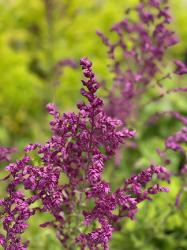
German for ‘threshold castle’, this hearty easy-care Salvia is both a visual feast and a pollinator’s mecca. The vibrant 2-lipped blooms are steeped in luscious rosy-purple shades as they crowd onto upright, multibranched spiky racemes from June ’til early fall. Beneath the drop-dead gorgeous flowers, notched lance-shaped grayish green leaves fashion a textural, aromatic woody-based clump that promises head-turning good looks, plus deer, rabbit and drought resistance.
Blooms June–September
Size: 15" – 20" high x 12" – 18" wide.
Hardy to zone 4.
OUT OF PRODUCTION AT THIS TIME
Email me when this plant is available
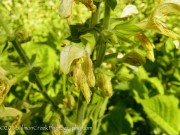
“Nubicola” means “dweller among the clouds,” and the name proclaims its hardiness. Clothed in large plentiful, arrow-shaped leaves, Himalayan Yellow Sage’s robust upright sticky stems buttress a wealth of yellow-flowered spires, with each uniquely colored bloom featuring tiny maroon spots plus an apple green calyx. Content in compost-rich, somewhat moist shady locations, this bushy perennial can be planted near Boltonia ‘Snowbank’ or Alcea ‘Blacknight’ to highlight its bold foliar vitality.
Blooms mid-August–October.
Size: 4' 0" – 5' 0" high x 3-1/2' wide.
Zone 6b.
Each $11.25
Though Linnaeus named this wildly unusual Salvia way back in the 1700s, you’ll be hard pressed to find it growing in anyone’s yard these days. Endemic to the Balkans, eastern Europe, Turkey and southwestern Russia, Nodding Sage sprouts an attractive low basal rosette clothed with large, textural arrowhead-shaped greenery beneath the perfect-for-cutting, pollinator-friendly posies, which look a bit like Wisteria blooms. The splendid, long-lasting blue-violet blossoms populate striking close-knit pendant clusters, gracefully flowing from the tips of sturdy, wide-branched, 4 ft. tall, reddish flowering stalks. Undeterred by hot humid summers, winter cold and light shade, Salvia nutans can embellish well-drained borders, rock gardens or natural-style plantings.
Blooms June–September
Size: 3' 0" – 4' 0" high x 12" – 18" wide.
Zone 5b/6.
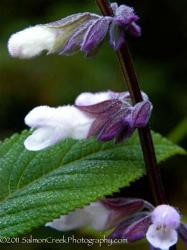
A stylish offspring of Salvia leucantha and possibly Salvia chiapensis, this chance seedling, named for Phyllis Norris, originated at the U.C. Santa Cruz Arboretum. It resembles Salvia ‘Waverly’, though its larger well-groomed frame is more hardy, its green leaves less coriaceous and its two-toned blooms more blue. Attention-grabbing foot long spires are embellished with fuzzy light lavender flowers, each tended by an inky-purple calyx that’s green beneath. ‘Phyllis’ Fancy’ enjoys moderate water, good drainage and survives temperatures to 8°, but will die back to its roots.
Blooms August–October
Size: 4' 0" – 5' 0" high x 4' 0" – 5' 0" wide.
Zone 7/8.
OUT OF PRODUCTION AT THIS TIME
Email me when this plant is available
Hailed as one of the most drought tolerant plants in the trade, this tough-as-nails evergreen Salvia can handle a California summer without water, sandy or clay soil in either coastal, mountainous or desert gardens, and sports good looks to boot. Masses of sparkling blue-violet flowers populate spaced ball-shaped clusters atop a rounded, somewhat woody frame with aromatic ashy green leaves.
A chance seedling of Salvia clevelandii and Salvia leucophylla selected by Las Palitas Nursery owner Bert Wilson, ‘Pozo Blue’ makes a handsome addition to fresh or dried arrangements, as well as rocky banks and dry borders, while attracting butterflies, California Quail, hummingbirds, and plant enthusiasts. It can handle a California summer without water and sandy or clay soil in either coastal, mountainous or desert gardens.
Blooms June – October.
Size: 5' 0" high x 5' 0" wide.
Zone 7/8.
An irresistible 2014 Jelitto Perennial Seeds introduction, ‘Sky Dance’ debuts elegant light sky-blue flowers that are coveted by gardeners, honey bees, butterflies and florists. Offering additional blossoms after deadheading, the tall, dense long-blooming spires rise above tight set medium green rosettes, shaped by wrinkled oblong foliage. This rugged, quibble-free Salvia appreciates well-drained sites and handles light shade.
Blooms June–August
Size: 20" high x 12" wide.
Zone 3/4.
Salvia pratensis ‘Swan Lake’ (P-1283)
Each $11.00
After years of breeding, Jelitto Seeds has just recently introduced this pure white Salvia. Rich green foliage with a wrinkled texture and ruffled margins forms a lush, leafy mound beneath the upstanding snowy spikes. Each delicate, luminous flower nestles in a calyx on a tiny pedestal of small green bracts.
Showy ‘Swan Lake’s species name translates as “growing in meadows,” referring to its sunny native European haunts. A natural for relaxed garden settings amid grasses, it easily accepts varied conditions, especially cold temperatures.
Blooms June–August.
Size: 20" high x 12" wide.
Zone 3/4.
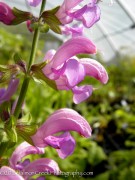
Arising from Jelitto’s Meadow Ballet Series, this steadfast 2008 introduction features erect, tall spires dressed in pretty dark pink hooded flowers with rosy carmine tints on extended lower lips. Long-petioled, green crinkled leaves forge a handsome thick leafy mound, anchoring the vividly colored summer-long display that entices bees and doesn’t ask for much—only sunshine, deadheading and average garden soil.
Blooms June – August.
Size: 20" high x 12" wide.
Zone 3/4.
Back in 2005, Jelitto first introduced the Meadow Ballet Blend, an easy-to-grow hardy group of Meadow Clary Sages renowned for their richly hued, perfect-for-cutting floral spikes that unfurl within a year of being planted. ‘Twilight Serenade’ is the most recent individual color selection, boasting distinctively hooded, lavish blue-violet blossoms on upright 20 in. green stems above an attractive green rosette of ruffly toothed leaves.
Though the species is a sun-loving, European meadow denizen, this long blooming cultivar will look fantastic right up front in your garden accompanied by Bouteloua curtipendula and Elymus ‘Canyon Prince’.
Blooms June ? August.
Size: 20" high x 12" wide.
Zone 3/4.
Handsome troops of sturdy sable-colored branching stems curve up and out, delivering plump reddish violet blooms with white stamens and fuzzy mahogany calyxes in ornate widely spaced whorls. Described by long petioles and delineated veins on the flip sides, extremely large, bright green leaves compile a lush looking basal mound.
Populating Chinese rocky slopes, stream banks and forest margins, this Salvia is legendary for its medicinal attributes, prefers well-drained soil and is striking alongside Euphorbia longifolia’s chartreuse blooms.
Blooms July – August
Size: 18" – 2' 0" high x 2' 0" wide.
Zone 7/8.
A mainstay at the back of the border, this regal Salvia is a cross between Salvia guaranitica and Salvia gesneriiflora. Hummingbird-friendly spikes of vibrant violet-blue blooms rise above the textured mint green leaves, adding glorious color all summer until frost. ‘Purple Majesty’s upright stance and cool shades complement the warmer hues of Helianthus ‘Shelia’s Sunshine’ for a splendid autumn union.
Blooms June–early November
Size: 5' 0" – 6' 0" high x 3' 0" wide.
Zone 7/8.
Salvia purpurea ‘Lavender Lace’ (P-2190)
Each $10.50
A nectar-laden dream for bees, butterflies and hummingbirds, tubular vivid purple flowers crowd onto scores of chubby, branched 6 to 10 in. long terminal panicles. The electrifying late season display, which spans 2 or 3 months, festoons a large handsome shrub-like silhouette characterized by vigorous outward-arching stems and serrated, prominently-veined green foliage with lighter flip sides. Relishing a well-drained, compost-enriched site and a half day of sun, this fast-growing deer-resistant Salvia needs winter protection around 25° and appreciates an early spring cut back to ensure a more compact appearance.
Blooms September–May
Size: 5' 0" – 6' 0" high x 4' 0" – 5' 0" wide.
Hardy to zone 9.
Each $11.75
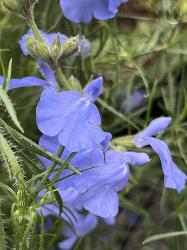
Originally from the high mountains in Mexico, this plant comes to us from Jim Lockman of Oakland, California. It has a soft character with delicate blue flowers and fine textured, light green, spidery leaves, which grow on basal stems. You can cut it back for a second bloom before it disappears in winter. Salvia reptans is perfect in drifts, as an accent in the rockery, or contrasted with Rudbeckia ‘Swiss Gold’.
Blooms August–September.
Size: 15" high x 2' 0" wide.
Hardy to zone 7.
Salvia reptans ‘West Texas Form’ (P-1587)
Each $11.75

The richest shade of cobalt-blue saturates these late-blooming flowers as they ride a sea of tall stems clad in needle-like green leaves. Discovered in the Davis Mountains at 4000 ft. by Pat McNeal’s keen eye and closely related to Salvia pitcheri, this no-fuss Texas beauty is uniquely upright, while the species is lax. West Texas Form endures drought, poor rocky soil and humidity. An association with Gaura ‘Summer Breeze’ makes for a carefree look.
Blooms mid-August--September
Size: 3' 0" high x 3' 0" wide.
Zone 6/7.
Salvia sclarea ‘Vatican White’ (P-1136)
Each $10.75

This noble architectural Sage has been grown in almost every botanical sanctuary throughout human history. The catalog of its uses is extensive: a flavoring for wines and liqueurs; an oil for perfumes, potpourri and incense, while medicinally, it is reputed to ease stomach ailments and stop the aging process! Today, ‘Vatican White’ is cultivated for its stately vigorous bearing in the border. Large, gray-green leaves—lance-shaped and leathery—remain attractive throughout the season. Each stalwart stem is topped with widely branching panicles of pure white blossoms and big, brilliant whorled white bracts, which lend a floral effect from May to September. Clary Sage requires little water or attention, but insists on excellent drainage.
Blooms June–July
Size: 2-1/2' high x 2' 0" wide.
Hardy to zone 4.

Intricate bicolored flowers, a lovely blend of lilac-colored upper petals and midnight purple lower lips, are held by muted pink calyxes against a foil of handsome, dark green, textured foliage. Perfect for the rocky border or atop a wall where its detail can be enjoyed at eye level, this small-leafed hardy Mexican native combines well with Phygelius and Geranium ‘Buxton’s Variety’ and its long lasting blooms make an excellent addition to any flower arrangement.
Blooms June–October.
Size: 3' 0" high x 3' 0" wide.
Hardy to zone 8.
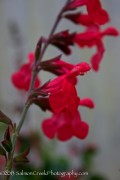
Discovered by Art Petty of Austin, Texas, this dream Salvia cross inherits the best qualities of both its parents. Like darcyi, it features fantastically colored blooms, and like microphylla, its good-looking stance is short and compact.
Summer brings plentiful, 15 in. spikes of warm-hued, dark orange-red flowers and by fall, the round-tipped, somewhat reflective green foliage is completely blanketed by them. Renown for an easy going, stalwart and floriferous nature, ‘Silke’s Dream’ tantalizes us with its passionate display, while counterposing Salvia corrugata’s deep blue spires.
Blooms July–October.
Size: 2' 0" high x 3' 0" wide.
Hardy to zone 7.
OUT OF PRODUCTION AT THIS TIME
Email me when this plant is available
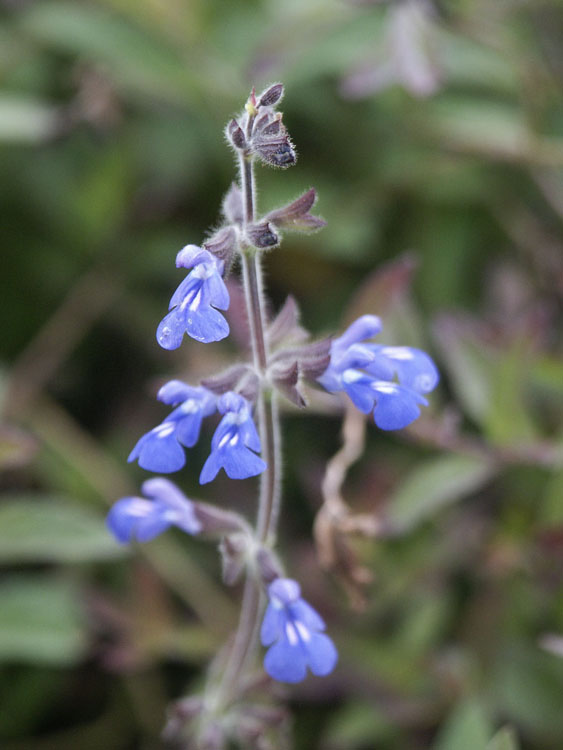
Indigenous to the Mexican province Sinaloa, this compact bushy Salvia displays tantalizing color. Low growing stems initially trail on the ground, concealed by dark green, textured leaves infused with plum-purple hues, and bronze-tinted new growth. Well above the narrow foliage, deep blue, airy, upright spikes feature spaced whorls of sable calyxes and vivid flowers marked with two subtle white lines on each lower lip.
A charmer for the border’s edge, a stone wall or the rock garden, Salvia sinaloensis spreads by underground rhizomes, disappears in the winter, and appreciates well drained soil.
Blooms June–October.
Size: 6" – 10" high x 15" – 18" wide.
Hardy to zone 8.
Salvia x sylvestris ‘Dear Anja’ (P-2156)
OUT OF PRODUCTION AT THIS TIME
Email me when this plant is available
Witness the unbeatable late season floral display atop a neat loosely branched foundation and you’ll see why acclaimed designer Piet Oudolf named this selection for his wife. Heightened by white-rimmed lips and dark magenta calyces, the bee-friendly profusion of close-set iridescent blue-violet blossoms populate erect, slim, purple-stemmed spires all summer long. Appreciative of well-rotted compost and good drainage, aromatic lance-shaped medium green leaves with scalloped edges and slightly hairy flip sides characterize ‘Dear Anja’s winsome clumping habit that makes a stalwart addition to coastal plantings, borders and natural-style gardens.
Blooms July–September
Size: 18" – 2-1/2' high x 18" – 2-1/2' wide.
Hardy to zone 4.
Salvia x sylvestris ‘Tanzerin’ (P-2191)
OUT OF PRODUCTION AT THIS TIME
Email me when this plant is available

Coined ‘Dancer’ by Ernest Pagels, the esteemed plantsman who introduced it, this reliable AGM winner unfurls a replete pollinator’s mecca of tall graceful spires packed with rich violet-blue flowers plus vibrant reddish bracts and calyces. Crinkled lanceolate green leaves offer scented textural appeal beneath the long-lasting prismatic blossoms. A winsome semievergreen hybrid between nemorosa and pratensis, ‘Tanzerin’s snug bushy clump can be planted alongside Achillea ‘Inca Gold’ and Hemerocallis citrina, while obliging coastal conditions, various soil types and cold winters.
Blooms June–August
Size: 2' 0" – 2-3/4' high x 12" – 18" wide.
Hardy to zone 5.
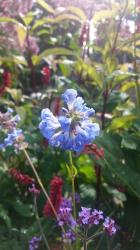
Uliginosa means "of the marshes", in this case those between the forests of southern Brazil and Argentina's fertile pampas. Eye-catching white flecked azure blue flowers soar atop slender branching stems lined with narrow lance-shaped green leaves. A quick-to-establish colonizing perennial, Bog Sage presents an airy, strong and erect habit that doesn't need staking and flourishes in moist niches along streams or ponds and in ordinary garden conditions, even tolerating heavy or dry soil. For a spectacular effect, plant it alongside Anemone 'Andrea Atkinson'.
Blooms August–October.
Size: 4' 0" – 5' 0" high x 15" & spreading wide.
Hardy to zone 6.
Salvia ‘Ultra Violet’ (P-1773)
OUT OF PRODUCTION AT THIS TIME
Email me when this plant is available
Selected by Lauren Springer and Scott Ogden in Ft. Collins, Colorado, this fantastic new hybrid originated from a hummingbird initiated cross between Salvia lycioides and Salvia greggii. Legions of iridescent deep violet-pink 2-lipped blooms dazzle upright flower spikes and fine cut glistening deep green foliage that shapes a compact rounded habit. Cold hardy ‘Ultra Violet’ lures butterflies, appreciates well-drained soil, withstands drought, rabbits and deer, and looks ultra-fine in just about any landscape. (uspp#21,411)
Blooms June–September.
Size: 18" – 20" high x 2' 0" – 2-1/4' wide.
Zone 5b.
OUT OF PRODUCTION AT THIS TIME
Email me when this plant is available

Hailing from the warm, moist mountainous haunts of Mexico, Guatemala and Honduras, this tender, yet irresistible Salvia produces inch long, whorled deep blue-violet flowers on short stalks above a verdurous semi-upright mass. Lax stems carry velvety soft, dark green textured leaves that are deltoid in shape and saw-toothed along the margins. Tended by green calyxes, the long blooming flowers feature unusual incurved lower lips with light undersides and provide a cool-colored late season fanfare, complementing roses and pink or white blooming Asters.
A topnotch container specimen, Blue Bush Sage needs to be protected when temperatures drop to 30°.
Blooms August – November.
Size: 2' 0" – 3' 0" high x 2' 0" – 3' 0" wide.
Zone 9/10.
-869.jpg)
This showy Salvia makes a dazzling container plant. The large, layered, burgundy buds have pointed sepals and open into numerous dark carmine-colored flowers with wine-red calyxes. Intriguing raised red ridges run horizontally around the stems at regular intervals like rungs on a ladder, connecting the reddish leaf petioles of each pair of opposite leaves.
Be sure to provide winter protection, as Salvia vanhoutii is hardy only in warmer climates.
Blooms July–October.
Size: 4' 0" high x 4' 0" wide.
Hardy to zone 9.


Ornate closely spaced whorls of tiny 2-lipped, warm rosy-purple flowers adorn lengthy, lax, upright and arching stems that rise from a fuzzy-looking, compact rounded base. A friend to bees, butterflies and other visitors, long-lasting showy blooms linger above broad, textural somewhat triangular medium green leaves. Favoring good drainage and a trimming after the flowers fade, ‘Purple Rain’ abides lean, rocky and dry sites plus imparts a noteworthy presence to rock walls, borders or wilder settings.
Blooms June–October
Size: 18" high x 18" wide.
Hardy to zone 5.
Each $12.00
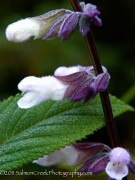
Like a well planned composition, this Salvia blends white fuzzy flowers, blushed with the palest of pinks and predominate purple calyxes against a graceful foil of textured grayish green foliage.
Given to us by David Salmon of High Country Gardens, we planted it in front of Cotinus ‘Grace’, whose leaves repeat the deep color of ‘Santa Barbara’s calyxes.
Blooms late June–early November.
Size: 3' 0" high x 3' 0" wide.
Hardy to zone 8.
Sanguisorba
Burnet
A profusion of oblong, catkin-like blooms resides above decorative pinnate foliage, generating interest for months. Happiest in a sunny spot where the soil stays moist, these hearty perennials offer contrasting clarity to softer, less defined forms in borders or in more naturalized plantings.
Sanguisorba ‘Autumn Red’ (P-2298)
Each $13.00
British plant maven Marina Christopher includes ′Autumn Red’ in her top-dozen favorite Sanguisorba list. This energetic seldom-offered cultivar is characterized by large, saw-toothed loosely-arranged pinnate blue-green foliage that tosses wide-branched skyward stems with burr-like dark red blooms, unfurling from late summer ’til November. Ensconce alongside other long-legged plants such as Aster ‘Orpheus’, Verbena bonariensis and Panicum ‘Northwind’ for colorful late season vignettes.
Blooms July–October
Size: 5' 0" – 6' 0" high x 2' 0" – 2-1/2' wide.
Hardy to zone 4.

Casting strong vertical accents and captivating close-up details, this must-have new cultivar bears long, antique-toned rosy-red blooms studded with soft-looking black-tipped stamens. Handsome pairs of notched matte-green leaves loosely ascend the staunch, branching, red-tinged flower stalks. ‘Blackthorn’s splendid, upright cylindrical blossoms beckon butterflies and plant lovers alike, while its steadfast lusty habit can mingle with other late bloomers such as Persicaria ‘Taurus’ and Pennisetum ‘Karley Rose’.
Blooms July–October
Size: 5' 0" – 6' 0" high x 2' 0" – 2-1/2' wide.
Hardy to zone 4.
Sanguisorba ‘Burr Blanc’ (P-2207)
Each $13.00

Often touted as one of the best Sanguisorbas to grow, this elegant hybrid seedling was selected from a group of Sanguisorba tenuifolia var. parviflora plants by Graham Gough at Marchants Hardy Plants, his East Sussex nursery. Copious cylindrical green buds plus elongated, slightly nodding snowy-white flowers gambol upon lithe, upright branching stems and attractive pinnate foliage that’s intricately cut into narrow, saw-toothed oblong deep green leaflets. Presenting a reliable and peppy persona coupled with long-standing pollinator-friendly blooms, ‘Burr Blanc’ can be situated amid Boltonia ‘Snowbank’, Eryngium yuccifolium and Echinops ‘Platinum Blue’ for luminous color echoes.
Blooms July–mid October
Size: 4' 0" – 5' 0" high x 18" – 2' 0" wide.
Hardy to zone 4.
Sanguisorba ‘Cangshan Cranberry’ (P-2072)
Each $13.00
Collected in Yunnan, China by plantsman Dan Hinkley, ‘Cangshan Cranberry’ is a stately late-blooming cultivar whose daring bottlebrush-like flowers are suffused with fabulous dusky-burgundy hues. Inspiring British nursery proprietor Marina Christopher to coin the namesake, copious close-knit bobbles roost atop tall, slender, self-supporting reddish stems, while oval-shaped blue-green leaflets distinguish the winsome jagged-edged pinnate foliage. A dynamic counterpoint to blousey trusses and spires as well as daisy-style blooms, this tall, seldom offered Sanguisorba can be peppered amid Phlox ‘Miss Mary’, Veronicastrum ‘Pink Glow’ and Helianthus salicifolia to great effect. (DJHC535)
Blooms August–October
Size: 5' 0" – 6' 0" high x 18" wide.
Hardy to zone 4.
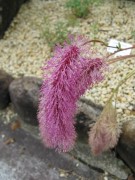
Casting a fanciful feminine style all summer long, this gorgeous aptly named Japanese perennial premiers bushy purplish pink tails that gracefully arch downward on upright stems. A clumping base sprouts gray-green scalloped leaves, which showcase intriguing origami-like patterns as they unfurl and promise a long lasting well-groomed appearance.
Blooms June–August
Size: 18" – 2' 0" high x 15" wide.
Hardy to zone 4.

Fluffy, decidedly feminine and pendulous, the 5 in. long squirrel tail blooms are draped like bodacious pink boas atop sparsely leafed sturdy stems. Loose fine textured filaments define the look-at-me flowers, while red-infused petioles and bold blue-green pinnate leaves further enhance the beguilement.
Blooms July–September
Size: 20" – 2-1/2' high x 15" – 18" wide.
Hardy to zone 5.
Sanguisorba menziesii (P-1148)
Each $11.50
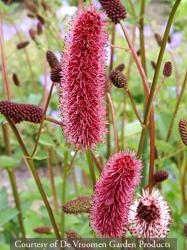
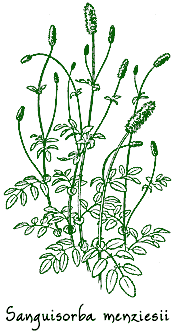
An assemblage of finespun, feathery blue-green foliage gives way to slender branching stems and tightly arranged, finger-length blooms in vivid dark red shades. Earlier to flower than other Sanguisorbas, this enticing perennial cavorts with Nepeta ‘Summer Magic’ and Festuca mairei in our border.
Blooms May–July
Size: 2-3/4' high x 16" – 18" wide.
Hardy to zone 4.
Sanguisorba menziesii ‘Wake Up’ (P-2192)
Each $13.00

This head-turning British cultivar swaggers lanky and close-knit oblong pinkish maroon tassels that are longer and fluffier than the Pacific Northwest species. Laden with prominent hairs, the long-lasting floral hoopla crests strong upright stems and a robust foundation of decorative blue-gray pinnate foliage. Ensconce anywhere ‘Wake-Up’s whimsical blooms can be backlit by the afternoon sun and relished even when past their prime.
Blooms May–July
Size: 2' 0" – 3' 0" high x 16" – 18" wide.
Hardy to zone 4.
Residing on wiry arching stems, soft pink fingerlike spikes look fluffy and feminine. They nod lazy heads at the handsome bushy mass of tranquil blue-green leaves marked by indented margins that grows below.
Blooms July–September.
Size: 2-1/2' high x 18" wide.
Hardy to zone 4.
Sanguisorba officinalis (P-1158)
Each $11.50

Embodied with astringent properties, the Great Burnet’s handsome foliage can soothe not only inflamed skin but your senses as well. The vigorous rounded clump is an airy cool green arrangement of deeply cut, toothed basal leaves that promotes a relaxed presence in the landscape. Come summer, the mood changes when thin, tall branching stems lift tightly set, blood-red bottlebrushes. Create a fervor, plant en masse and savor the alluring color and shape of the flowers, especially when juxtaposed against Seseli gummiferum’s white umbels.
Blooms July–October
Size: 3' 0" – 4' 0" high x 2' 0" wide.
Hardy to zone 4.
Sanguisorba officinalis ‘Arnhem’ (P-2193)
Each $13.00
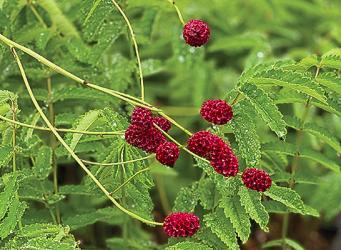
Stretching to grand heights, lean branching stems cushion a mesmerizing see-through froth of snug ovoid-shaped blooms dressed in lavish burgundy-red shades. The suave saw-toothed pinnate foliage shapes a loose green foliar mound that is anchored by sturdy underground rhizomes. Popular among bees, floral artists and plant lovers, ‘Arnhem’ can be interspersed with other natural-style mates such as Panicum ‘Purple Tears’ and Aster ‘Fellowship’ for easy-care late season oomph.
Blooms July–October
Size: 5' 0" – 6' 0" high x 2' 0" – 2-1/2' wide.
Hardy to zone 4.
Sanguisorba officinalis ‘Chocolate Tip’ (P-1786)
Each $13.25
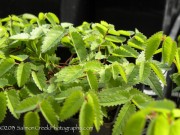
Famed for its ferny blue-green foliage that’s burnished with chocolate overtones, this superb new cultivar produces a lavish plethora of egg-shaped brunette-tinged maroon flowers. The dense chubby blooms uniquely open from the bottom up, while perched on firm slender branching stems. ‘Chocolate Tip’ brings a buoyant stance and dark saturated hues to the colorful blooms of Agastache ‘Bolero’ and Aster ‘Harrington’s Pink’ in our border.
Blooms July?October.
Size: 2-1/4' high x 16" wide.
Hardy to zone 4.
Sanguisorba officinalis ‘Crimson Queen’ (P-2071)
Each $13.00
Close-set, long-lasting and early to unfurl, myriad egg-shaped Merlot-hued blooms adorn a sprightly array of wire-thin branching stalks. This striking new cultivar sprouts decorative toothed bluish green leaves, crafting an enduring, no-quibble basal mound that’s ideal for borders, cutting gardens or meadow-style plantings.
Blooms July–September
Size: 3-1/3' high x 18" – 2' 0" wide.
Hardy to zone 4.
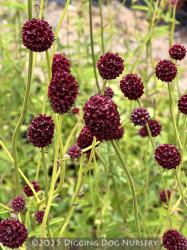
This lofty new English introduction arose as a chance seedling at Martin Lowne’s West Acre Gardens. Soaring far beyond a refined substantial green clump of 15 toothed, somewhat oblong pinnate leaflets, the sturdy self-supporting stalks plus loosely arranged branched stems host countless plump wine-hued blooms heightened by deep plum shades. Tailor-made for cut arrangements, ‘Martin’s Mulberry’s dense full-toned blooms and willowy visage can be threaded amongst bedfellows like Cephalaria gigantea, Aster ‘Violetta’ and Molinia ‘Skyracer’.
Blooms July–October
Size: 5' 0" – 6' 0" high x 2' 0" – 2-1/2' wide.
Hardy to zone 4.

Set in motion by the slightest breeze, the bevy of chubby maroon thimbles roosts on firm, willowy branched stems above a ferny low-growing fresh green clump. ‘Morning Select’ is a new vigorous perennial that Scottish Sanguisorba expert Gavin McNaughton includes on his favorites’ list. Abiding wet conditions and clay soil, its pinnate foliage plus early blooming close-knit flowers afford a wild yet refined touch in borders or natural-style plantings with Pennisetum ‘Karley Rose’, Calamagrostis brachytricha and Cirsium ‘Trevor’s Blue Wonder’ nearby.
Blooms June–August
Size: 2-1/2' – 3-1/2' high x 16" – 18" wide.
Hardy to zone 4.

Derived from a Korean collection of Sanguisorba officinalis, this snazzy Sanguisorba was selected by Dutch plantsman Piet Oudolf for its deep ruby-red bobbles, perched on tall stiffer stems. Whether in the border or a meadow planting, a vase or frost covered in the garden’s winter light, their distinctive silhouette inspires as much drama as a gathering thunder head. A green bed of pinnate foliage with toothed leaflets launches the strong floral display that can be superimposed against tall silver-plumed Miscanthus, whorled Veronicastrum blooms and Helianthus ‘Capenoch Star’.
Blooms July–October
Size: 3' 0" – 4' 0" high x 2' 0" wide.
Hardy to zone 4.
Sanguisorba officinalis ‘Tanna’ (P-0864)
Each $12.00
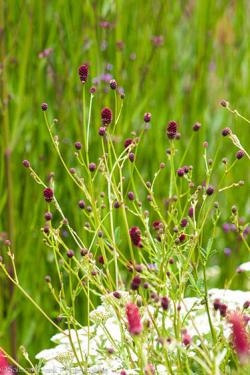
Well suited for the smaller scale garden, ‘Tanna’s mound of ferny leaf fronds makes an elegant host to the cylindrical, burgundy flower spires that playfully top foot-long stems. Cultivated since the Middle Ages, the cucumber-flavored foliage has been a welcome addition in the salad bowl.
Blooms July–August.
Size: 18" high x 12" wide.
Hardy to zone 4.
Sanguisorba ‘Pink Tanna’ (P-2021)
Each $12.00
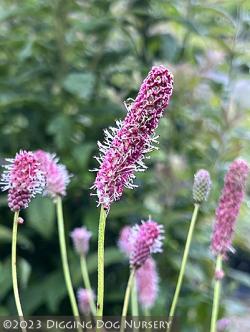
A ‘see-through’ plethora of dense, muted pink catkins with pale rose-colored stamens alight sturdy, erect branching stems above a decorative, grass-green basal clump. Beloved by butterflies, the spry, furry blooms turn a warm russet-brown as they age, while close-set, toothed pinnate foliage offers bright canary-yellow hues for autumn. Adaptable to clay soil and larger than the more well-known ‘Tanna’, this durable perennial’s easy-to-blend, long-lasting blooms can be massed near the front of the border or in a less formal venue.
Blooms July–September
Size: 18" – 2' 0" high x 18" wide.
Hardy to zone 4.
Sanguisorba ‘Proud Mary’ (P-2212)
Each $13.00
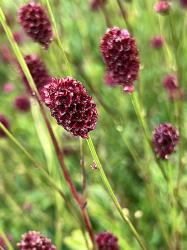
Proudly poised atop tall, lean, erect branching stems, the breezy array of snug burgundy-red blooms with reddish pink stamens promises both a visual feast plus a nectar-rich refuge. The deep green pinnate foliage is divided into small coarsely-toothed rounded leaflets, comprising a tasteful low-lying mound that’s more compact than many other Sanguisorbas. This new seldom-offered British cultivar can be debuted right up front, where its full-toned bobbles throw a mysterious guise upon midborder plants.
Blooms July–September
Size: 2' 0" high x 12" – 15" wide.
Hardy to zone 4.
Sanguisorba tenuifolia ‘Alba’ (P-1465)
Each $11.75
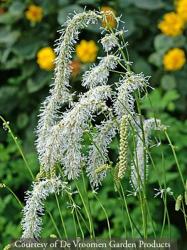
A textural delight of saw-toothed, finely divided leaves, ‘Alba’s clump-forming mound lays the foundation for slim, fluffy white, drooping blooms. The elegant cylindrical flowers are abundantly borne on tall branching stems, well above the energetic greenery, and look like luminous catkins caught in a rain shower.
Blooms September–October
Size: 4' 0" – 5' 0" high x 18" – 2' 0" wide.
Hardy to zone 4.
Sanguisorba tenuifolia ‘Pink Elephant’ (P-2077)
Each $13.00
Buoyed by lanky branching stems, a plethora of long finger-shaped raspberry-hued inflorescences first emerge in a nearly horizontal fashion, then artfully curve and become more pendulous with age. Light pink stamens lend an intriguing bicolored effect to the tight long-lasting blooms that mesmerize butterflies and hummingbirds above slender, pinnate green leaves sporting finely serrated margins. A tall upright perennial native to moist Asiatic meadows, ‘Pink Elephant’s airy textural demeanor can be massed or planted singularly in borders as well as more naturalized venues.
Blooms July–early October
Size: 3' 0" – 5' 0" high x 2' 0" – 3' 0" wide.
Hardy to zone 4.
Saponaria
Soapwort
Naturals for the rockery or a well drained border, their paired leaves promise a lengthy profusion of flowers in showy clusters. These low growing European charmers like a lean soil.
Saponaria x lempergii ‘Max Frei’ (P-0133)
Each $10.25

Pretty, open bouquets of pure pink, 1 in. wide blossoms blanket ‘Max Frei’s noninvasive mass of slender and shiny green leaves nearly all summer long. Let this superlative Swiss hybrid spill over the edge of a bed, beautify a rock wall, or act as a colorful, small-scale ground cover.
Blooms June–October
Size: 12" high x 18" – 2' 0" wide.
Hardy to zone 5.

Nestled on tidy, tight green evergreen cushions of very thin, succulentlike foliage, the myriad, nearly stemless blooms in ravishing rose-red hues stage an unbeatable display. Tuck Polish Soapwort into a crevice and you’ll soon see why this pumilio and caespitosa hybrid is touted as one of the most superb, freely flowering additions for the rockery.
Blooms June–July.
Size: 3" – 4" high x 12" wide.
Hardy to zone 4.
Saxifraga
Saxifrage
Saxifraga stolonifera ‘Maroon Beauty’ (P-1819)
Each $11.00
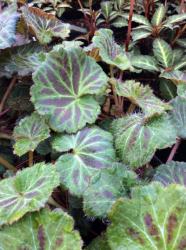
Named for its slender strawberry-like red runners and flashy maroon undersides, this colonizing Saxifraga hosts intricately etched evergreen rosettes of thick rounded gray-green leaves with scalloped margins, silver hairs and pewter veins. Rising above the low growing velvet soft mat, wispy 5-petaled pink-tinged white flowers are loosely arranged on delicate 18 in. stalks. Appreciative of shade and evenly moist well-drained soil, ‘Maroon Beauty’ lends enchanting accents to the woodlands, rockery or a small container.
Blooms June–October.
Size: 15" – 18" high x 6" – 8" wide.
Hardy to zone 7.
Scabiosa
Prized by gardeners and pollinators for their bounty of endearing pincushion-like blooms that unfurl from spring ’til frost, our Scabiosa offerings tout a trouble-free habit with fetching finely-divided foliage that thwarts deer and enjoys fertile, somewhat limy, well-drained niches.
Each $10.75
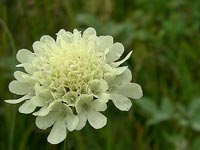
With charm to sway, this undemanding Scabiosa celebrates a seemingly endless supply of pincushion-style flowers in hushed lemon shades. Finely dissected gray-green foliage furnishes a tasteful, soft-looking tuft from which wiry branched stems arise. A first-rate cut flower, the carefree display is heightened by intriguing etched green buds, and happily lends itself to a cottage garden or a more natural setting.
Blooms July–September
Size: 2-1/2' high x 3' 0" wide.
Hardy to zone 5.
Scabiosa superba ‘Mongolian Mist’ (P-2252)
OUT OF PRODUCTION AT THIS TIME
Email me when this plant is available
Discovered during a 1997 Great Plants of Nebraska expedition in the mountains of Inner Mongolia, this easily grown cultivar promises spectacular flowers plus untold vigor. The refined textural mound of elliptic to oblong-shaped deep green basal leaves unleashes exceptional purple-blue pincushions alighting firm 18 in. stems. Adored by butterflies but not deer, ‘Mongolian Mist’s elegant profile can grace well-drained borders, pollinator gardens, rockeries and bouquets.
Blooms June–September
Size: 12" – 18" high x 12" wide.
Zone 3b/4.
Schizostylis
African/Flag Lily
These South African evergreen bulbs promise to ease the sadness that comes at summer’s end by offering a burst of fresh autumn color.
Schizostylis coccinea ‘Alba’ (P-0419)
OUT OF PRODUCTION AT THIS TIME
Email me when this plant is available
Blooming on each 18 in. stem above green, sword- shaped blades are 10 to 30 snow white, starlike flowers. We contrast the blooms and foliage with the textured, golden leaves of Geranium ‘Ann Folkard’.
Blooms September – December.
Size: 18" high x 10" wide.
Hardy to zone 6.
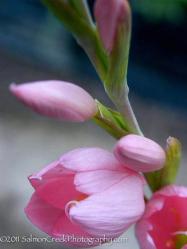
This South African genus of evergreen bulbs promises to ease the sadness that comes at summer's end by offering a burst of fresh autumn color. Slim buds and upfacing soft pink blooms stand amidst an ebullient forest of strapping greenery. Let it flourish in a pot on the patio, where its plentiful flowers are close at hand.
Blooms September–October.
Size: 2' 0" high x 10" wide.
Hardy to zone 6.
Schizostylis coccinea ‘Sunrise’ (P-0809)
OUT OF PRODUCTION AT THIS TIME
Email me when this plant is available

With an extended blooming period and bigger blossoms than most other Schizostylis, lily-esque ‘Sunrise’ is likely to brighten your Christmas table. Slim buds and deep pink blooms stand amidst an ebullient forest of strapping greenery. Let it flourish in a pot on the patio, where its plentiful flowers are close at hand.
Blooms September–December.
Size: 15" high x 10" wide.
Hardy to zone 6.
Schizostylis coccinea ‘Zeal Salmon’ (P-0555)
Each $10.75

This South African Iris relative splashes lusty deep salmon-pink hues upon the late season garden. Springing from rhizomatous roots, grassy leafed blades present slender spikes garnished with narrow pointed buds plus satiny, cup-shaped Gladiola-like blooms, which open wider as the day progresses. ‘Zeal Salmon’ is exemplary atop a stone wall, along stairs, near the front of the border or in a container where it prefers evenly moist fertile soil.
Blooms September–October
Size: 15" high x 10" wide.
Hardy to zone 6.
Scutellaria
Skullcap
Late in the season, after the charming hooded blooms have faded, pairs of scallop-shaped, warmly colored seed capsules, resembling small inverted skullcaps, add intriguing detail to these Mint family members. Our easy-to-grow selections appreciate a sunny, quick-draining site, and happily mingle with medium-sized Euphorbias, Diascias and Nepetas.
Scutellaria alpina ‘Moonbeam’ (P-1226)
Each $11.00
The species originates in the mountains of southern Europe and Russia, and this ‘Moonbeam’s lush and low bushy mat of scalloped, ovate green-gray leaves is an excellent foil for its crowded clusters of light yellow blooms. Trailing stems turn upward and, at their tips, Snapdragon-like flowers form a four-sided raceme.
Requiring well drained soil and shade during hot afternoons, this little treasure goes well in a container, or in the rockery with Edraianthus graminifolius and Origanum libanoticum.
Blooms May–September.
Size: 10" high x 12" wide.
Hardy to zone 5.
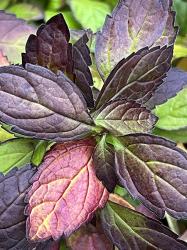
Originating as a seedling from a naturally occurring hybrid between two eastern U.S. natives Scutellaria ovata and Scutellaria serrata, this first-rate 2022 cultivar was selected by West Virginia-based horticulturalist Peter Heus and introduced by Plants Nouveau. Dapper serrated mint-green leaves with plum-colored margins distinguish the snug semievergreen clump, which premiers large Salvia-like violet-blue and white bicolored flowers on upright, branching dark maroon stems. Happiest in filtered light plus well-drained soil, ‘Appalachian Blues’s amenable deer-resistant habit attracts numerous bee species, tolerates occasional drought and promises long-lasting charm for sunny, moist meadow plantings, mixed borders and woodland peripheries.
Blooms late May–July
Size: 15" – 2' 0" high x 15" – 2' 0" wide.
Hardy to zone 4.
Scutellaria incana ‘White Sky’ (P-2157)
OUT OF PRODUCTION AT THIS TIME
Email me when this plant is available
While the native species roams the meadows, open woodlands and shady stream banks and roadsides of the eastern U.S., this new easily grown white-flowering cultivar will illuminate the bright shadows of your garden. Openly arranged, tubular pearl-hued flowers with a hood-like upper lip, light green bracts and plenty of pollinator allure distinguish glimmering 6 in. terminal racemes. Softened by ultrafine downy gray hairs, the dense bushy habit forms an attractive small colony of erect square green stems clothed in ovate, round-toothed smoky-green leaves with pointed tips and a bitter taste that keeps bunnies and deer at bay.
Blooms mid June–August
Size: 2' 0" – 3' 0" high x 12" – 2' 0" wide.
Hardy to zone 4.
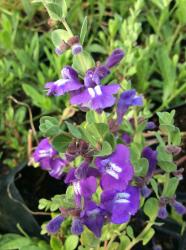
Legendary for its tenacious ability to conquer hot sunny niches, this engaging well-groomed Kansas denizen was introduced by the Nebraska Statewide Arboretum. Small, oval-shaped pubescent gray-green leaves and branching, upright square stems cushion a showy, long-lasting display of tubular deep blue-violet flowers, each highlighted with 2 small white streaks. Relishing minimal fertility plus sharp drainage, ‘Smoky Hills’ is second-to-none when massed as a low mounding ground cover that readily enhances borders, meadows, rock gardens and native plantings while warding off the bunnies.
Blooms May–July
Size: 6" – 12" high x 10" – 14" wide.
Hardy to zone 4.
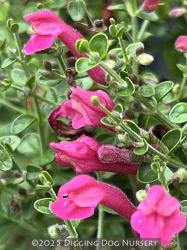
For its tidy swath of dark pink infill, the masses of Snapdragon-like blooms adorning the diminutive, glossy green foliage of ‘Texas Rose’ get our vote. With a dainty, yet durable, low profile, it makes an endearing addition to the rockery, or along a pathway nestled amidst Dianthus ‘Mendlesham Maid’ and Geranium ‘Johnson’s Blue’.
Blooms mid-June–mid-October.
Size: 4" – 6" high x 15" wide.
Hardy to zone 7.
Sedum
Stonecrop
Tough yet delightful, beloved by butterflies and bees, these succulent perennials flourish even in lean and mean soil. Asserting a decidedly horizontal element to the garden, long-lasting flat umbels of starry flowers emerge from buds in broccoli-like clusters. Supported by stout sturdy stems, the blooms mature through a range of colors, extending the visual delight well into winter. Asking only for good drainage along with an occasional sip of water, Sedums are durable, reliable and virtually maintenance free.
Thanks to Norseco Nursery in Quebec for this newly improved form of the commonly planted ‘Autumn Joy’. Strong, stout stems lined with dentate, gray-green, fleshy leaves support the more substantial, longer lasting blooms. Bold clusters of closely packed, rosy pink flowers age to a salmon bronze, later casting coppery red shades upon the autumn landscape.
Blooms August–October.
Size: 2' 0" high x 18" wide.
Hardy to zone 4.
Each $10.50
Celebrated for a stout stature and tightset domed blooms, this English cultivar’s large radiant rosy pink heads galvanize butterflies, bees and plant enthusiasts with late season color and nectar galore. A sturdy swell of thick compact magenta-suffused stalks plus fleshy greenish-gray leaves anchors the long lasting floral display. Exhibiting a trim no-coddle disposition, ‘Carl’ makes a fabulous cut flower, fresh or dried, and stand-out presentation in a favored pot, the rockery or a mixed border, especially when sprinkled alongside other toughies such as Eragrostis spectabilis or Eryngium ‘Big Blue’.
Blooms August–October
Size: 16" – 18" high x 18" – 2' 0" wide.
Hardy to zone 4.
Sedum globosum ‘Old Man’s Bones’ (P-1774)
Each $10.50
It’s a wee stretch of the imagination, but maybe some of you will see the resemblance between the slightly rounded and closely stacked, short, chubby succulent leaves and an elderly gent’s vertebrae. Curious-looking dark green leaves craft a dense low creeping mat that attractively flushes red, purple and bronze tones in hot sun or cold weather. Brightened by clusters of starry yellow flowers, this distinctive tough-as-nails Sedum tantalizes butterflies, blankets the rockery or infills steps and endures drought once established.
Blooms June–August.
Size: 4" high x 8" – 12" wide.
Hardy to zone 3.
Sedum ‘Jose Aubergine’ (P-1858)
Each $11.00
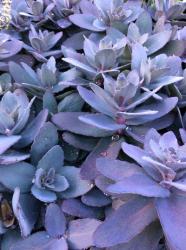
A recent Silver Medal winner at Boskoop’s European Plantarium Show, this Jose De Buck introduction struts a shorter, more manageable habit than its well-known parent, Sedum ‘Purple Emperor’. Distinctive ovate leaves, bathed in opulent greenish eggplant shades, line the upstanding stocky dark stems, inspiring the cultivar name. At home in the border’s frontlines or in a patio container, ‘Jose Aubergine’s compact stature creates a sumptuous foil for the flashy slabs of tiny bright pink blooms that lure bees as well as other garden visitors.
Blooms August–October
Size: 20" high x 16" – 18" wide.
Hardy to zone 3.
Each $11.00

A new German cultivar, ‘Matrona’s smoky-pink flowers darken to russet as winter approaches. Her red-hued, glistening stems are upright and clad with luscious blue-green foliage, each fleshy leaf exhibiting a vermilion midrib and margin. Plant our softly colored “matron” with Scutellaria ‘Smoky Hills’ and Andropogon ‘Black Mountain’ for an arresting union.
Blooms August–October
Size: 18" – 2' 0" high x 18" wide.
Hardy to zone 4.
Bathed with opulent reddish purple hues and shouldered by swarthy stems that won’t flop, its impressive broad domed heads earned this highly sought after Sedum the coveted AGM award. ‘Mr. Goodbud’ is definitely handsome, sporting a tailored, well-branched, bushy and compact habit clad in pearly green succulent leaves. Spirited bicolored contrast is created when green buds initially reveal creamy toned petals, which quickly transmute vivid deeper shades. (pp#17,671)
Blooms August – October.
Size: 18" high x 18" wide.
Hardy to zone 4.
Sedum ‘Purple Emperor’ (P-1301)
OUT OF PRODUCTION AT THIS TIME
Email me when this plant is available
Injecting an element of mysterious allure, ‘Purple Emperor’ hosts tantalizing, deep purple succulent foliage fastened to compact, dark reddish pink stems. Summer offers a perky lift as tight set, plum-hued buds become star-shaped flowers in dusky orchid shades.
Introduced by England’s former Washfield Nursery after it was discovered in the Sussex garden of the proprietor’s parents, this new, regally colored Sedum holds the coveted 2002 Outstanding Perennial Plant Award, and is an enticing counterpoint for Euphorbia ‘Black Pearl’.
Blooms July–August.
Size: 15" high x 18" wide.
Hardy to zone 4.
Sedum spectabile ‘Indian Chief’ (P-1401)
Each $10.50

‘Indian Chief’ commands our attention when its tranquil, pale green leaves and thick stems shoulder fiery red slabs of concentrated flowers. As the garden begins to wane, the hot-blooded blooms develop rusty chestnut hues and impart a vivid intensity to companions like Molinia ‘Bergfreund’ or Rudbeckia ‘Swiss Gold’.
Blooms August–October.
Size: 2' 0" high x 18" wide.
Hardy to zone 4.
Sedum spectabile ‘Neon’ (P-1143)
Each $10.50
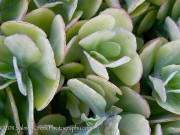
An enhanced sport of Sedum ‘Brilliant’, this Sedum promises to dazzle. Larger, rounder, and more intensely colored than its relation, ‘Neon’ boasts close-knit bouquets with electrifying magenta flowers, which offset the cool shades of its succulent, light green foliage.
Blooms August–October.
Size: 18" – 2' 0" high x 18" wide.
Hardy to zone 4.
Sedum spectabile ‘Septemberglut’ (P-1901)
Each $10.50
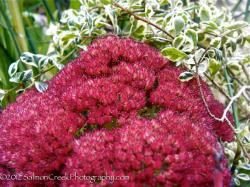
Glut is German for ‘glow’, and aptly describes the vivid rosy red shades of this popular Sedum’s broad floral domes. A welcome destination for bees and butterflies, copious blooms are propped upon swarthy upright stems transmuting distinctive full-toned dark red hues in autumn, which effectively contrast the smooth fleshy gray-green leaves below and complement Molinia ‘Moorhexe’ and Geranium ‘Ann Folkard’.
Blooms August–October
Size: 18" – 2' 0" high x 18" wide.
Hardy to zone 4.
Sedum spurium ‘John Creech’ (P-1775)
Each $10.50
Thanks to Dr. John Creech, the former director of the U.S. National Arboretum, this cute, yet durable, little Sedum found its way into our country from a Siberian Botanical Garden. A showy late blooming flourish of rose pink flowers festoons the small, round scalloped green leaves, which knit a tightset, low spreading, lush and succulent cover. Weed smothering, energetic and hardy, ‘John Creech’ is unfazed by light shade and is excellent for edging a pathway, creating a green roof and softening stonewalls or containers.
Blooms August–September.
Size: 3" – 4" high x 6" – 9" wide.
Hardy to zone 3.
Sedum spurium ‘Voodoo’ (P-1776)
Each $10.25
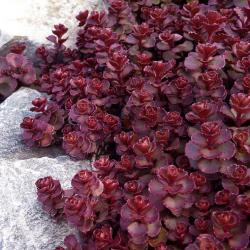
There’s no escaping the spell that these devilishly handsome dark leaves and neon bright blooms will cast on you. Topped with a rosy red summertime icing of tiny star-shaped flowers arranged in 4-branched clusters, the rich mahogany red foliage is thick, obovate and toothed at the tips, while shrouding merlot-infused trailing stems. ‘Voodoo’ conjures a short trouble free carpet-like ground cover that relishes sandy or rocky soil, stays evergreen in milder climates, detests over watering and abates erosion.
Blooms June–August.
Size: 4" – 6" high x 2' 0" wide.
Hardy to zone 3.
Dense purplish red umbels, hefty dark maroon stems and thick pointed blue-green leaves with notched margins create an extraordinary carousel of color. Recently introduced by Jelitto Seeds, this late blooming Sedum can be planted in the rockery or a perennial bed where its lavish and contrasting hues play out best en masse.
The showy heads make great cut flowers, fresh or dried, but leave some in the garden for the butterflies, and for your enjoyment once the frost etches them in silver.
Blooms August – October.
Size: 16" high x 16" wide.
Hardy to zone 4.
A hardy Russian native whose uninspired name belies its enduring good looks. ‘Hab Gray’ makes a bold statement with long, upright yet arching stems and intriguing colors. Stiff reddish stalks are offset by succulent foliage that’s glaucous, smoky purple and blush-tinged, while large domed clusters of tiny rose-hued buds and refreshing lemon-white flowers sojourn above.
Blooms August – October.
Size: 16" high x 16" wide.
Zone 3/4.
Sedum telephium ‘Karfunkelstein’ (P-1717)
Each $11.00
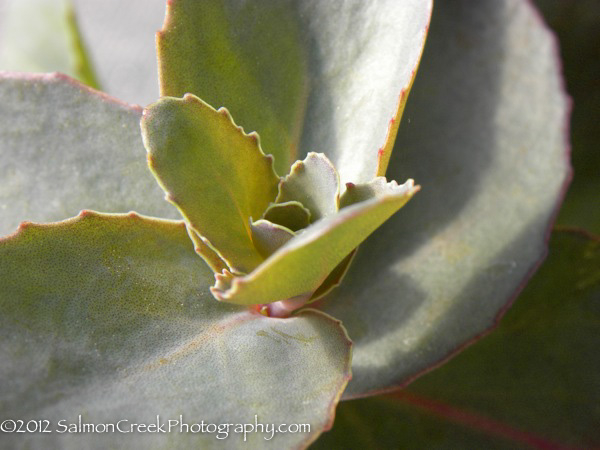
Fancied as one of the rising stars at the 2006 RHS Sedum Trials, this exceptional Ernest Pagels prodigy has a dainty demeanor. Copious rose red buds and small dusky pink flower heads crest a close-knit sea of upright multibranched green stems infused with lavish beet red shades. Ideal for gardens where space is scarce, the short stalwart stalks never flop and are clad in toothed gray-green spoon-shaped leaves with slate purple overtones, heightening ‘Karfunkelstein’s prismatic presentation.
Blooms August – October.
Size: 16" – 18" high x 18" – 2' 0" wide.
Hardy to zone 4.
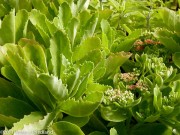
An old favorite of Gertrude Jekyll’s, this low growing beauty delivers dense cauliflowerlike clusters elegantly painted in rosy reds and burnished with auburn tones come late fall. Straight maroon stems and toothed, pur-ple-infused, thick gray-green leaves create a trim, compelling foundation for the plush floral slices.
Blooms August – October.
Size: 18" high x 12" wide.
Zone 3/4.
Sedum telephium ‘Red Cauli’ (P-1716)
Each $10.75
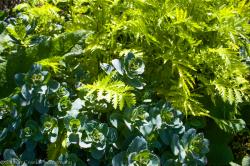
A vibrant carousel of color and a neat compact visage earned this popular Sedum the RHS Garden Merit award in 2006 and a place in our border. Flashy cardinal-hued arching stems and notched blue-green succulent leaves with purple tinges elevate pale rosy buds and bright pink clustered flowers, which age to a dark ruby red.
Let ‘Red Cauli’ festoon a patio container or a pathway’s edge, accompanying other late blooming companions such as Salvia reptans West Texas Form and Calamagrostis foliosa.
Blooms July – October.
Size: 12" – 15" high x 18" wide.
Zone 3/4.
Each $10.50

A probable Sedum telephium ‘Atropurpureum’ and Sedum ‘Ruby Glow’ descendant, this award-winning richly colored Sedum arose as a chance seedling in Vera Jameson’s garden some 50 years ago. Firm, slightly arching purplish stems plus thick succulent-style blue-green leaves, infused with deep violet and burgundy hues by late summer, boost a galaxy of petite star-like dusty-pink blooms. Coveted by bees, butterflies and floral designers, the large 3 to 5 in. wide flattened heads, unfurling from showy coral-pink buds, impart easy-to-blend antique tones and a compelling presence that lasts well into winter.
Blooms July–October
Size: 9" – 12" high x 9" – 12" wide.
Hardy to zone 4.
Selinum
Cow Parsley

This refined Himalayan beauty happens to be one of our favorite perennial umbellifers. With untold elegance, infinitely divided leaves emphasize a delicate, gossamer-like transparency. The compact yet airy green canopy is framed by distinctive, purple-infused branching stems that uphold a sparkling late season display of flattened white umbels. Subduing the riotous array of summertime blooms, it seldom needs staking, appreciates a moist well-draining locale and can be sited amid Filipendula ‘Multiplex’ and Echinacea ‘Magnus Superior’.
Blooms June–August
Size: 3' 0" – 4' 0" high x 18" wide.
Hardy to zone 6.
Each $11.25
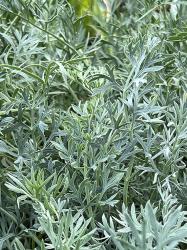
Dressed in lacy sophistication, thick upright stems entertain a wealth of fern-like silver-gray foliage. The star-shaped, snow-white flowers blush with pinkish hues as they explode from tight white buds, featuring huge, branched flat umbels perched well above the poised finespun foundation. A mesmerizing focal point for the perennial border or a meadow planting, Moon Carrot fancies well-drained soil, makes an exquisite cut flower and easily reseeds, offering some consolation for the fact that it can be short-lived.
Blooms July–August
Size: 2' 0" – 3' 0" high x 10" – 15" wide.
Hardy to zone 5.
Sidalcea
Prairie Mallow
Indigenous to western and central North America, these easily grown Mallow family members are adored for their 5-petaled Hollyhock-like blooms that embellish terminal racemes above a basal clump of attractive toothed greenery. Well-drained sites, cool summers, shelter from strong winds and a fall cutback ensure their prosperity, while hot humid weather makes them sulk.

A largely extinct wildflower indigenous to Oregon’s Willamette Valley and several small areas in Washington, this long-lived easy-care clumping perennial is touted as one of the best butterfly plants in the Pacific Northwest. Short thick rhizomes sustain an attractive fast-growing foundation of tall, strong-branched hairy stalks and rounded, fuzzy gray-green leaves that are palmately divided into toothed segments with pointed tips. Providing untold ornamental merit plus a reliable nectar source for native bees and hummingbirds, pretty cup-shaped white to soft pink blooms clutched by fleecy green calyces embellish the openly-arranged upright spires. Amenable Meadow Checkermallow can be added to cut creations, pollinator gardens or woodland edges, where it appreciates good drainage and endures dry conditions once established.
Blooms late May–July
Size: 3' 0" – 6' 0" high x 12" – 2' 0" wide.
Hardy to zone 5.
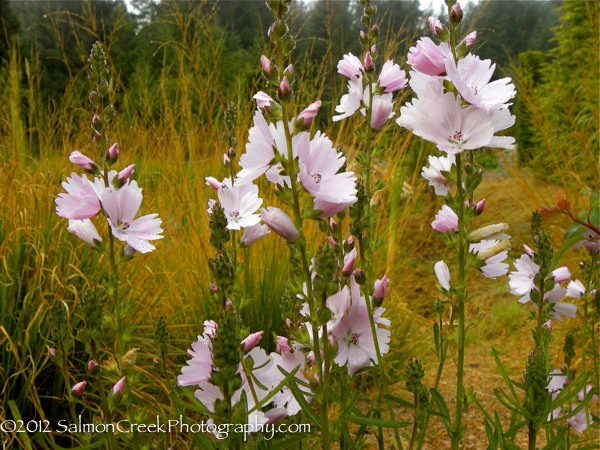
‘Elsie Heugh’ is a well-loved old favorite, whose popularity has never waned and for good reason. Easygoing, best en masse and equally at home in a cottage garden or a more formal border, this distinctive Hollyhock relative presents fringed shell-pink blooms with a silky luster. The lovely, 5-petaled Mallow-like blossoms are borne on erect, stately branching spikes above a good-looking green basal clump of round, shallowly lobed leaves that become smaller and more fingered as they ascend the flowering stems. Provide a fertile loamy soil and cut back after blooming to promote a flowery encore.
Blooms July–mid-September
Size: 2' 0" – 3' 0" high x 15" wide.
Hardy to zone 5.
Sidalcea malviflora ‘Palustre’ (P-2112)
Each $11.50
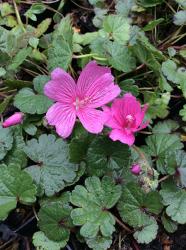
While California’s native Sidalcea malviflora roams our wild grasslands, this vigorous evergreen selection can endow your garden with Hollyhock-like blooms atop thick, scalloped dark-hued greenery. The close-knit carpet-like habit manifests a bevy of butterfly-friendly cup-shaped deep rosy-pink flowers that unfurl all summer long. Abiding dry conditions as well as gophers, Checker Bloom makes a handsome small-scale ground cover for meadows, borders or coastal plantings and looks its best when watered moderately.
Blooms June–mid-September
Size: 6" – 10" high x 12" – 2' 0" wide.
Hardy to zone 6.
Coveted by butterflies, hummingbirds and floral designers, the dignified, tall upright spikes are generously garnished with glowing deep rose-colored blooms sporting a satin sheen. Large, free-flowing 5-petalled mallow-style blossoms stage a late-season swan song if Prairie Mallow’s compact bushy clump is cut back after the initial posies have faded. Clothed in rounded and lobed, glossy midgreen foliage, this stylish robust U.S. native can be added to meadow-like plantings or perennial borders, where it looks spectacular en masse, appreciates a hard yearly pruning, braves gophers plus most pests, but abhors hot humid summers.
Blooms July–September
Size: 2' 0" – 2-1/2' high x 20" – 2-1/2' wide.
Zone 4b/5.
OUT OF PRODUCTION AT THIS TIME
Email me when this plant is available
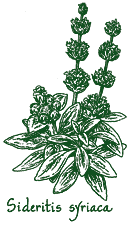
Endearing, yet rugged and a “cure-all” medicinal to boot, this plucky Cretan native should be welcomed into the dry, well draining crannies of your garden. Clustered small pale yellow flowers populate spaced whorls on short upright spires, which emerge from a dense low growing mound of slim gray foliage blanketed with downy soft, white hairs.
Nestle Sideritis syriaca between steps or rocks near other heat-loving plants such as Saponaria ‘Max Frei’, Origanum ‘Bristol Cross’, Lavenders and Santolina ‘Nana’. Brew a tea from its leaves and blooms to boost your immune system, combat colds, reduce inflammation and soothe your nerves.
Blooms June – September.
Size: 18" high x 18" wide.
Hardy to zone 8.
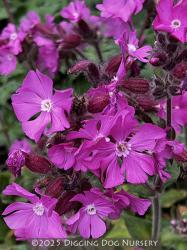
Though the nomenclature is questionable, one thing’s for certain—the oodles of delightful white-centered rich pink posies this hybrid Silene delivers. Discovered as a promising chance seedling by Dutch plantsman Gerardus Oudshoorn, the tidy, dense dark green mound furnishes fuzzy, oval-shaped evergreen leaves beneath starry, 1 in. Phlox-style flowers that pollinators and gardeners relish. Its attractive low-growing compact habit abides deer as well as drought, begs good drainage plus looks exceptional en masse, while sprucing up a rockery, pathway, living wall, border frontage or gravel garden. (pp#17,392)
Blooms May–mid-September
Size: 15" high x 18" wide.
Hardy to zone 5.
Silene uniflora ‘Compacta’ (P-1407)
Each $11.25
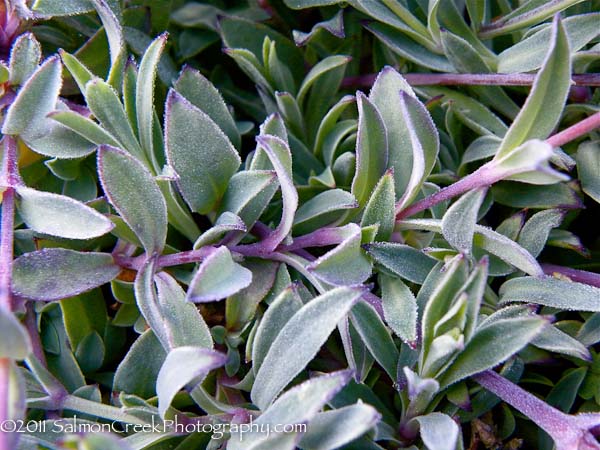
An all-star ground cover named for its decorative bladder-shaped calyxes, this European Campion stays smothered with dainty five-petaled flowers all summer long. Low gray-green cushions of tiny, lancelike fleshy leaves promote the pink-blushed white blooms and curious rosy sable-colored “balloons” on short, upright branching stems.
Easy going and irresistible, it can be nestled alongside a pathway, in a trough or the rockery, or anywhere its deeply rooted semi-evergreen habit is provided a well drained sunny site.
Blooms June–August.
Size: 6" high x 8" wide.
Hardy to zone 3.
Silene uniflora ‘Druetts Variegated’ (P-2113)
Each $11.25

This spiffy semievergreen mat is brightened by dainty, carnation-like white flowers with balloon-shaped bases and small, rounded fleshy gray-green leaves with creamy-white margins. The low-lying prostrate stems spread slowly, supporting a butterfly-friendly gathering of luminous 1 in. wide blooms on wiry erect stems all summer long. An endearing British cultivar, ‘Druett’s Variegated’s no-fuss habit can drape over walls or container lips as well as nestle between rocks and steps, where it conquers occasional dry spells, coastal conditions and some shade.
Blooms June–mid-September
Size: 2" – 4" high x 8" wide.
Hardy to zone 3.
Silphium integrifolium (P-1403)
Each $11.25

Bursting with optimism, this grandiose Midwestern native and Sunflower relative pushes a colony of stout and singular, erect stalks skyward. Coarse textured, rough-hewn lanceolate leaves march up purple-tinged stems, which branch out near their tops to deliver vivacious, 3 in. wide yellow daisies late in the season.
Beloved by songbirds and butterflies, long blooming and undaunted by heavy clay, Silphium integrifolium is undeniably tough and well suited for natural areas or borders alongside tall perennials such as Phlox ‘David’ or Salvia ‘Blue Ensign’.
Blooms August–September.
Size: 4' 0" – 6' 0" high x 2' 0" wide.
Hardy to zone 5.
Each $11.25
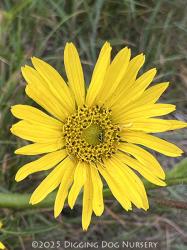
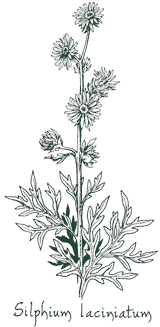
Widely distributed throughout our Midwestern tall grass prairies and once considered a life-saver for lost pioneers, this formidable sky-high perennial wields uniquely chiseled, up to 18 in. long basal leaves, which orient themselves on a north-south axis. Historically crafted into chewing gum by Native Americans, stiff bristly towering stems emit a bitter resin, while large white-haired foliage is cut nearly to the midrib, resembling a Pin Oak leaf. Along the upper reaches of thick stalks, a galaxy of huge, 5 in. wide sunflower-style blooms with yellow rays, yellow centers and hairy-edged green bracts make an exuberant summer long appearance. Employed as a bold coarse-textured backdrop in cottage gardens, wild flower plantings or mixed borders, its imposing colorful stature lures bees, butterflies and many a gardener.
Blooms July–September
Size: 5' 0" – 8' 0" high x 18" – 2-1/2' wide.
Hardy to zone 3.
Each $11.25

Limited to regions of Alabama, Tennessee and Georgia, this charming American Aster relation asserts a compelling architectural presence. The large, lance-shaped green basal leaves, some 10-15 in. long, sporting fine textured, dense bristly hairs, decrease in size as they ascend strong, branched fuzzy stems. Adored by birds, bees and butterflies, plentiful slightly fragrant clusters gather 2 in. daisy-like pale yellow flowers that afford a long, late season hurrah. Known to be peppered amid Liatris and Baptisia in Pennsylvania’s renowned Chanticleer garden, clumping S. mohrii makes a topnotch addition to perennial borders or naturalized plantings, where it craves a moderately dry rocky spot with low fertility and good drainage.
Blooms July–October
Size: 2' 0" – 5' 0" high x 2' 0" – 3' 0" wide.
Hardy to zone 5.
Sisyrinchium
This genus in the Iris family includes the familiar wildfloweres Blue-eyed Grass and Yellow-Eyed Grass.
Sisyrinchium angustifolium (P-1903)
Each $10.75
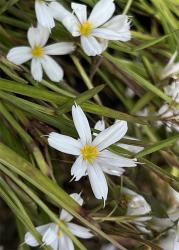
Endemic to damp open woods, fields and slopes throughout the eastern and southeastern U.S., this unusual white blooming form of the more commonly known, Blue-Eyed Grass was kindly given to us by grass aficionado, John Greenlee. Perfect for cut arrangements, delicate 6-petaled starry blossoms with golden eyes illuminate attractive loosely arranged flower clusters rising on winged branching stalks. The neat foot long green leaves compose a compact Iris-like tuft that prefers well-drained sufficiently moist crannies, favors being divided every 2 or 3 years and looks best when massed in cottage gardens, native plant settings, border fronts and rockeries./p>
Blooms May–June
Size: 12" – 18" high x 6" – 12" wide.
Hardy to zone 4.
Sisyrinchium striatum (P-0896)
Each $10.75
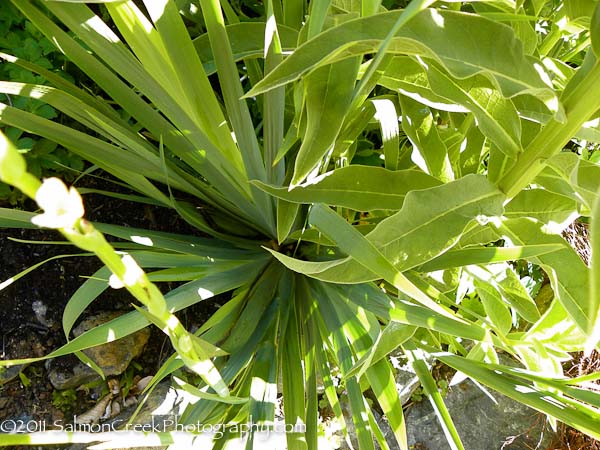
Native to Chile, this elegant member of the Iris family is notable for its creamy multitudes of pale yellow blooms; each is centered with a deep buttery colored eye, and the back of each petal has a pronounced purple stripe—hence the epithet “striatum.” The slender flowering stems arise from erect, evergreen clumps of spiky green-gray leaves that extend to 18 in. Set off Yellow Blue-Eyed Grass with the dark, leafy foliage of Eupatorium ‘Chocolate’.
Blooms June–July.
Size: 2' 0" high x 2' 0" wide.
Hardy to zone 7.
Solidago
Golden Rod
Solidago rugosa ‘Fireworks’ (P-0667)
Each $11.25
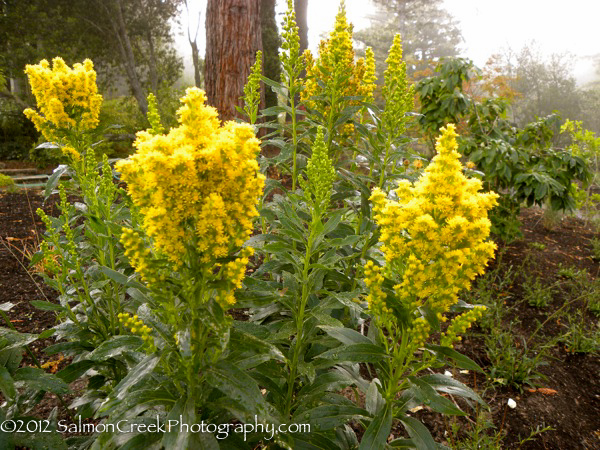
This cultivar should be called “finale,” a more accurate description of the multitude of fluffy golden sprays on nearly horizontal flowering spikes that seem to burst from this lush green bushy perennial like sizzling skyrockets. Excellent interspersed with Asters, grasses and other meadow plants, this familiar eastern species is a real treat in gardens west of the Rockies as well
Blooms September–October
Size: 4' 0" high x 2' 0" wide.
Hardy to zone 4.
Discovered as a chance seedling in Eden, NC by Dr. Richard Lighty, this award-winning Mt. Cuba introduction is quickly making its way into gardens throughout the U.S. and further abroad. Toothed, heart-style green leaves define a compact, semievergreen basal rosette beneath stiff, multibranching stems adorned with a profusion of densely covered golden-yellow spires. Counting garden designers, florists plus Hairstreaks, Sulphurs and Skippers among its many fans, ‘Golden Fleece’s superb, low-growing bushy ground cover delivers long-lasting, radiant late season blooms and thrives in sunny, somewhat fertile well-drained sites, yet tolerates varied conditions.
Blooms August–October
Size: 18" – 2' 0" high x 2' 0" wide.
Hardy to zone 4.
Originally found in Oklahoma’s rugged Wichita Mountains by nurseryman Steve Bieberich, this late-blooming, pollinator attractant is a splendid shining star at the acclaimed Lurie Garden in Chicago. Witness the tall, upright golden yellow wands beaming with tiny, tight set daisy-like blooms from late summer ’til the first frost, and you’ll see why. Garbed in narrow medium green foliage, the attractive tough-as-nails habit withstands heat, drought, deer and clay soil, but demands adequate air circulation and sharply drained soil.
Blooms August–October
Size: 2' 0" – 3' 0" high x 2' 0" – 2-1/2' wide.
Hardy to zone 4.
Stachys
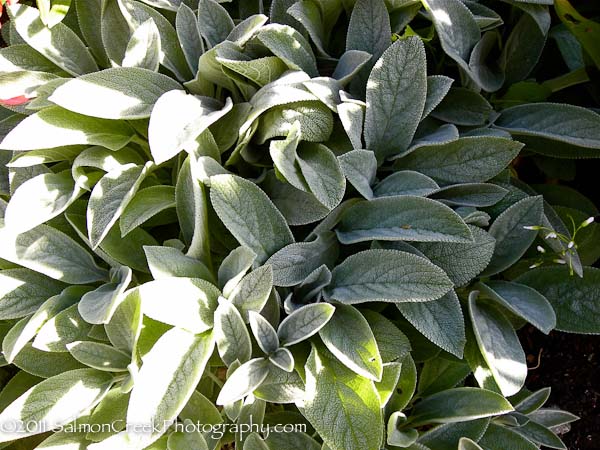
Lamb's Ear
The genus Stachys is like one of those families where every member is exceptional for something different—one bold, another soft, the next strong or perfectly smart—and they all get along with just about everybody. Diverse, sturdy, dependable, calling them mere ground covers is an understatement. Indispensable is more accurate.
Stachys byzantina ‘Helen von Stein’ (P-0136)
Each $11.25
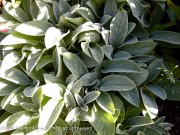

As soft as velvet, supple as suede, this Stachys has leaves so much like lamb’s ears they could twitch at flies! The palest silver, its foliage is broad (2-½ in. wide) with a finely serrated margin, and is a delight with Allium christophii.
Blooms July–September.
Size: 8" high x 3' 0" wide.
Hardy to zone 4.
Stachys byzantina ‘Silky Fleece’ (P-1404)
Each $11.50
As soft as velvet, supple as suede, this truly dwarf Stachys has small fuzzy leaves so much like lamb’s ears they could twitch at flies! The tantalizing foliage is the palest silver color and forms a low dense cushion for endearing spires of tiny, red-tinged lilac flowers. A recent Jelitto Seeds introduction, sun-loving ‘Silky Fleece’ easily mingles with many different plants and can be tucked into a rock garden or used as an edger.
Blooms July–August
Size: 10" high x 10" wide.
Hardy to zone 5.
Stachys byzantina ‘Silver Carpet’ (P-0137)
Each $11.25
Introduced by Norfolk’s W. Cunningham & Son Nursery, this fast-spreading velvet-soft carpet is beloved for its close-set woolly silver-gray leaves that remain evergreen in warmer areas. Casting plush luminous accents beneath roses, along border edges, amongst rocks and in between pavers, the valiant, ground cover-like habit seldom flowers, suppresses weeds and appreciates afternoon shade plus good drainage. ‘Silver Carpet’ endures shallow rocky soil, pollution, black walnuts, dry conditions and deer as well as rabbits, yet detests hot humid weather.
Size: 4" high x 12" – 18" wide.
Hardy to zone 4.
Stachys macrantha ‘Superba’ (P-1144)
Each $11.25
Poised on sturdy, curving stems, the showy terminal spikes host pretty pink tubular flowers and green calyxes arranged in evenly spaced whorls. Scalloped lance-like foliage forms an appealing, dark green leafy mound, some 20 in. below the long lasting blooms. Matched with Achillea ‘Hella Glashoff’ and Aster asperlus, this well-favored Stachys graces the edge of our pathway.
Blooms July–mid-October.
Size: 2-1/4' high x 2' 0" wide.
Hardy to zone 4.
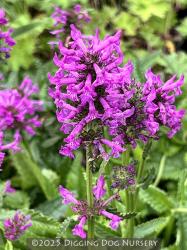
All summer long you can enjoy this versatile plant’s 3 in. dark rosy purple flowers held upright on short stalks. In the front of the border, a tight assemblage of green, scalloped leaves creates a crisp, tidy look that can be even further heightened by planting it alongside Stachys ‘Primrose Heron’ and Kniphofia ‘Vanilla’.
Blooms June–September.
Size: 10" – 12" high x 18" wide.
Hardy to zone 4.
Stachys minima (spathulata) (P-2114)
Each $11.25
A small-scale South African native, this adorable, seldom offered Stachys parades extraordinary quantities of fancy, 2-lipped tubular rosy-purple blooms squeezed onto short chubby spires. Lustrous mint-green leaves define the neat crimpled rosette that arises from slow spreading rhizomes. Second-to-none for forming a ground-hugging cover or festooning a patio container, Stachys minima detests hot humid weather, looks best when massed and delights butterflies, but not deer or rabbits.
Blooms June–July
Size: 5" – 8" high x 8" – 12" wide.
Hardy to zone 4.
Stachys monieri ‘Hummelo’ (P-1285)
Each $11.25
Painted in plush, deep fuchsia shades, droves of dense tubular flowers are lifted above a neat compact rosette on stout straight stalks. With crinkled and round-tipped medium green foliage that stays close to the ground, this perky, nearly evergreen perennial should be granted a front-row seat where its long-blooming act is easily savored.
Blooms June–August
Size: 18" high x 12" wide.
Hardy to zone 4.
Stachys officinalis ‘Densiflorus’ (P-2066)
Each $11.25
Closely resembling Stachys ‘Hummelo’, its larger cousin, this appealing pint-sized version is the perfect solution for a tight spot. The low growing close-knit rosette features wrinkled, scallop-edged shiny dark green leaves that propel countless crowded spikes of vibrant 2-lipped rosy purple flowers all summer long. Beloved by hummingbirds and butterflies, undemanding Dwarf Betony lends color-rich accents along pathways, border edges and steps.
Blooms June–August
Size: 8" – 10" high x 12" – 15" wide.
Hardy to zone 4.
Stokesia
Stokes Aster
Stokesia laevis ‘Alba’ (P-1678)
Each $11.25
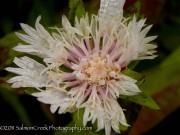
Named to honor the 18th century taxonomist, Dr. Jonathan Stokes, Stokesia is beloved by butterflies, tolerates heat, and appreciates a well-drained, sandy loam with ample moisture and winter mulch in colder climates.
Parading its Cornflower-like snowy white blossoms, this perfect-for-cutting Stokesia casts crisp luminous accents wherever it’s planted. Launched from a deep green and evergreen rosette of lance-shaped alternate leaves on long petioles, the stiff upright multibranched stems give way to fluffy blooms described by two rows of dainty ray flowers that eventually flush a light pink. The outer petals are deeply cut and surround a prominent pale central disc of intricately arranged, narrow tubular petals.
Blooms June – September.
Size: 18" high x 18" wide.
Hardy to zone 5.
Stokesia laevis ‘Mary Gregory’ (P-2115)
Each $11.25

While the hard-working native can be found in the bottomlands and ditches of the coastal plain, extending from North Carolina to Florida and Louisiana, this nectar-rich, cut-flower-perfect cultivar can be welcomed into your garden. Each lovely 3 to 4 in. wide primrose-yellow blossom hosts notched rays and a pincushion-like center of feathered disk florets. The long-blooming fluffy pastel-hued spectacle tops erect leafy stems plus an evergreen rosette with pest-free lanceolate greenery. Undaunted by drought and heat, ‘Mary Gregory’ relishes sun, good drainage, moderate moisture and winter mulch in cold northern
locales.
Blooms June–September
Size: 12" – 18" high x 12" – 18" wide.
Hardy to zone 5.
Strobilanthes attenuata (P-1323)
Each $11.00

Indigenous to Nepal and, sadly, seldom cultivated, this soft-looking bushy perennial furnishes legions of fetching Salvia-like blue-violet flowers, glistening cone-shaped purple buds and fuzzy, drip-tipped foliage. The curved, vividly colored blooms populate dense, late season terminal spikes for several months, while winsome green leaves cloak square, well-branched pubescent stalks. Happiest in bright shade with good drainage plus adequate moisture, Strobilanthes attenuata’s easy-care low mounding habit and large tubular blooms impart cool, composed summertime hues that set off perennials such as Crocosmia ‘Paul’s Best Yellow’ or Anemone ‘Wild Swan’.
Blooms August–October
Size: 2' 0" – 2-1/2' high x 2' 0" – 3' 0" wide.
Hardy to zone 9.
Stylophorum
Celadine Poppy
Stylophorum diphyllum (P-0882)
Each $12.00

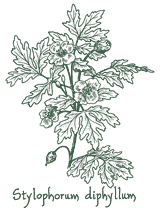
Brimming with charm, this showy undemanding wildflower is a sterling choice for naturalizing in a moist, lightly shaded locale. Paired and gray below, the blue-green Oak-like leaves and silver-haired, green nodding buds foster a wealth of 2 in. wide, golden yellow poppy-styled blossoms atop 12 to 18 in. stems.
Native to the eastern United States, the esteemed Celadine Poppy forms a long-lived, versatile leafy colony that may go summer dormant under dry conditions. It easily adapts to the shadows of a woodland or a more formal garden border, mingling amidst Asarum, finely cut Dicentra and Tiarella, while curious saffron-colored sap and fuzzy, 4-parted seed pods add intrigue.
Blooms March – April.
Size: 8" – 10" high x 2' 0" wide.
Hardy to zone 4.
Succisella
Devil’s Bit
Succisella inflexa ‘Frosted Pearls’ (P-1346)
Each $11.25
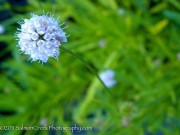
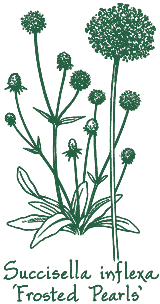
The cultivar name of this Jelitto Seeds’ introduction aptly denotes the flurry of snow-white Knautia-like spheres that are infused with the softest icy-blue glow. What evoked Devil’s Bit remains a mystery. Prolific pink-hued buds and sprightly flowers make a carefree presentation on thin branching stems above a tidy, long-lived bushy clump described by spatulate dark green leaves. Counting Cephalaria and Morina as perennial kin, ‘Frosted Pearls’ can be associated with ornamental grasses in the border or a more wild setting, while its marvelous flowers can enhance your next bouquet.
Blooms June–September
Size: 2-1/2' high x 18" wide.
Hardy to zone 5.
Symphyandra zangezura (P-1227)
Each $10.75
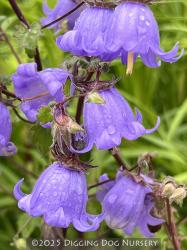
With a name that sounds like a fairy tale character, this rare Campanula cousin has charm to spare. Broadly flared bells painted in the prettiest shade of lilac dangle on delicate branching, dark leafy stems. Prominent anthers, dainty recurving petals and narrow ribbed buds enhance the profuse summer-long display, while a winsome bed of green, coarsely toothed, soft hairy leaves lolls below.
Flourishing in fertile well draining soil, but pouting during hot humid weather, the Rock Bellflower can be tucked into the rockery, a trough, or along a pathway where its endearing looks will surely bring a smile to your face.
Blooms June – August.
Size: 10" high x 15" wide.
Hardy to zone 5.
Symphytum x uplandicum ‘Axminster Gold’ (P-1624)
OUT OF PRODUCTION AT THIS TIME
Email me when this plant is available

With its large and artfully variegated textural leaves, this robust perennial becomes a bold centerpiece anywhere it’s planted. Vibrant lemon-yellows paint broad margins on grayish green arching foliage, a welcome sight especially in the quiet days of early spring. Gradually the distinctive basal mound grows taller, sending up flower stalks with elongated leaves and dainty small clusters of nodding blue blossoms.
Moist soil where it’s sunny, afternoon shade in drier sites, and a good shearing of the lanky stems will keep ‘Axminster Gold’ looking resplendent.
Blooms June – July.
Size: 18" high x 2-1/2' wide.
Hardy to zone 5.











